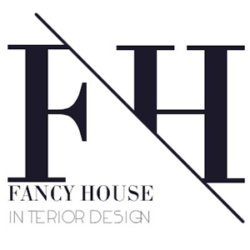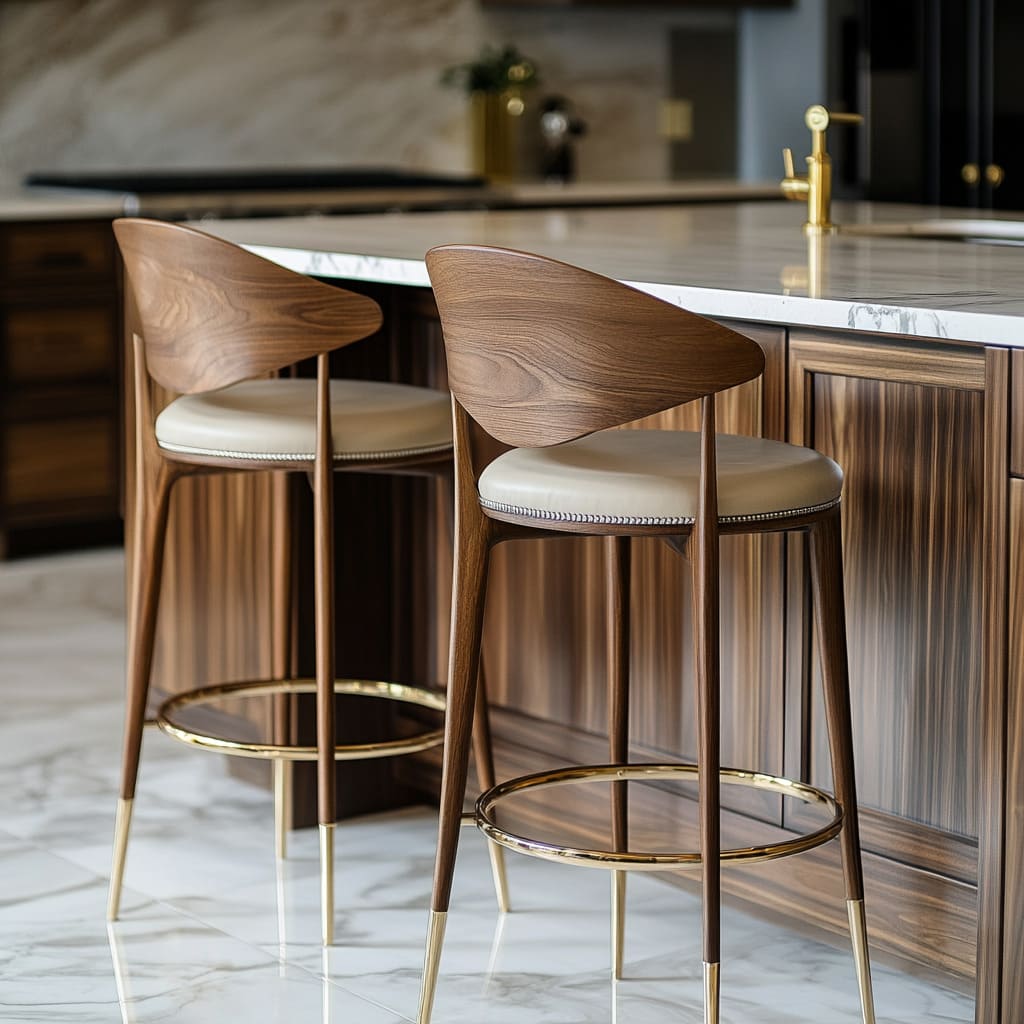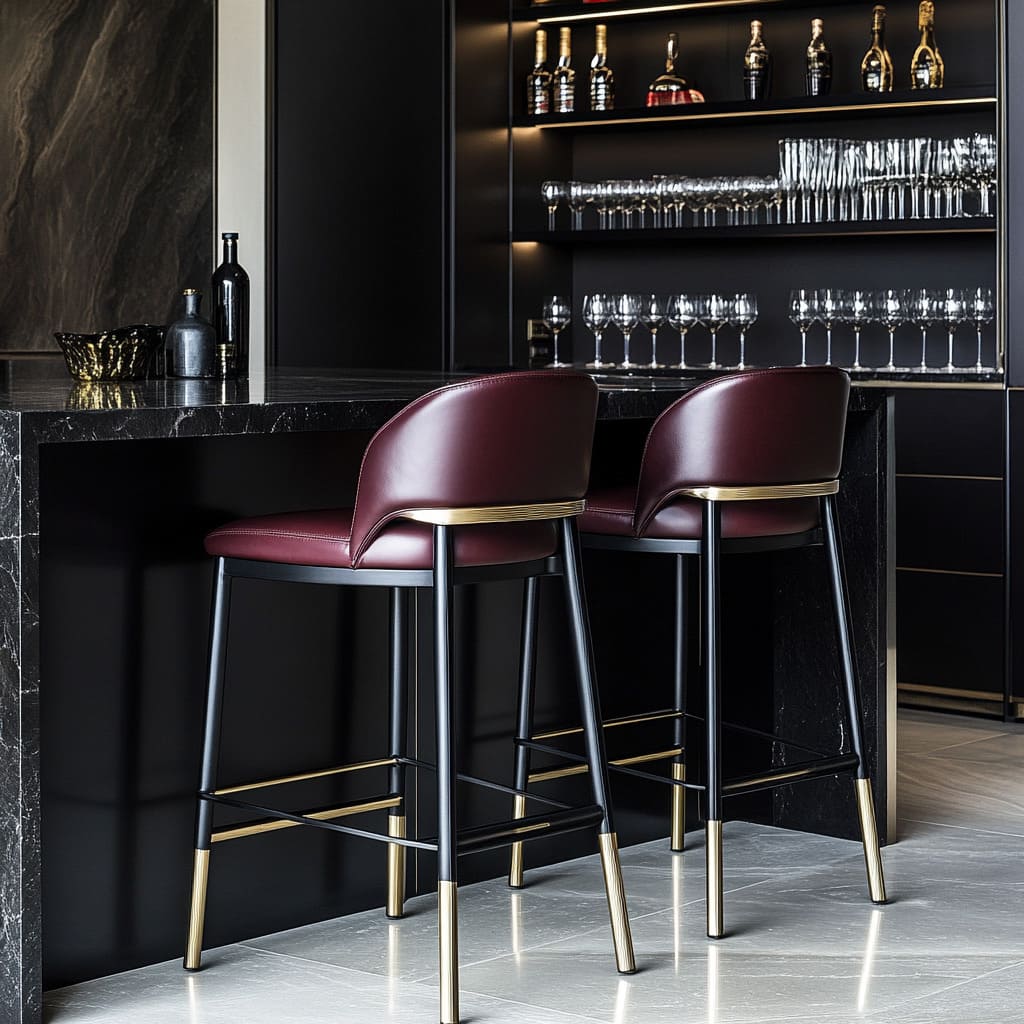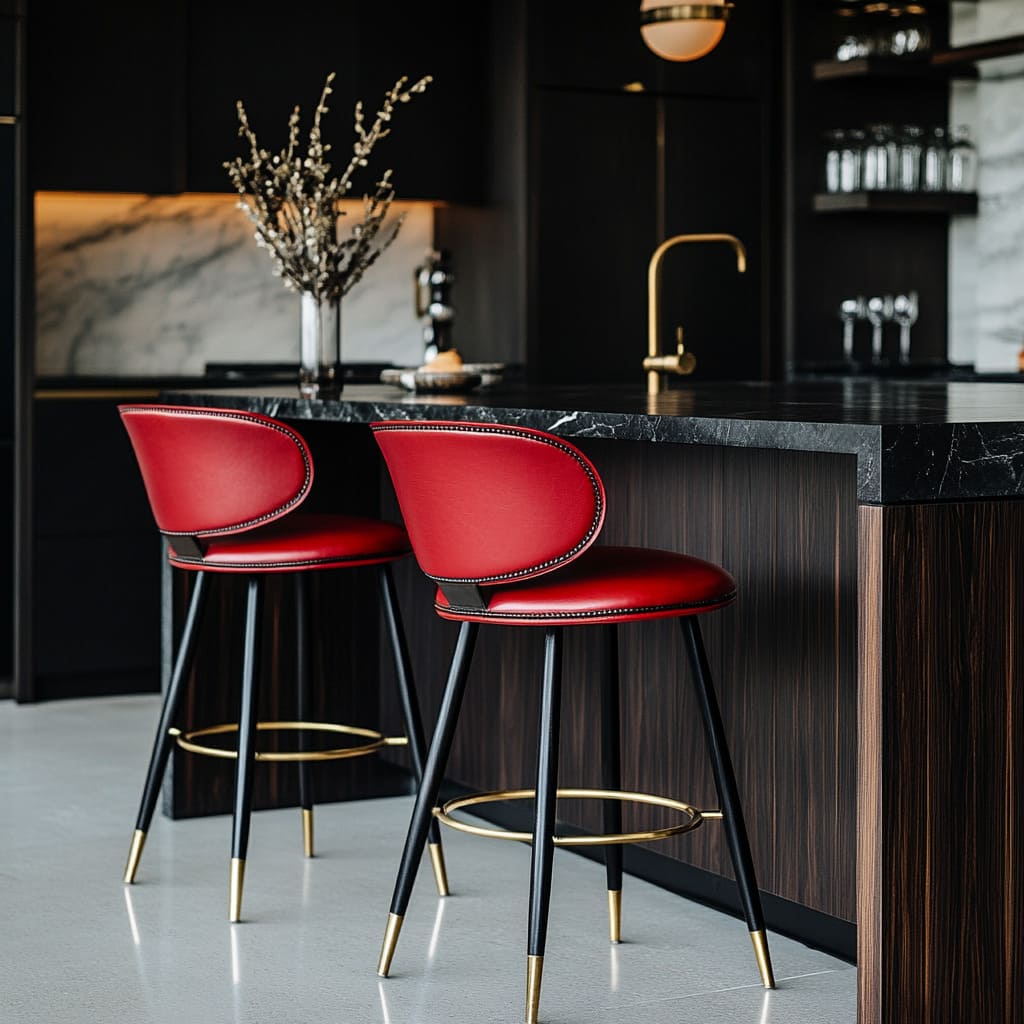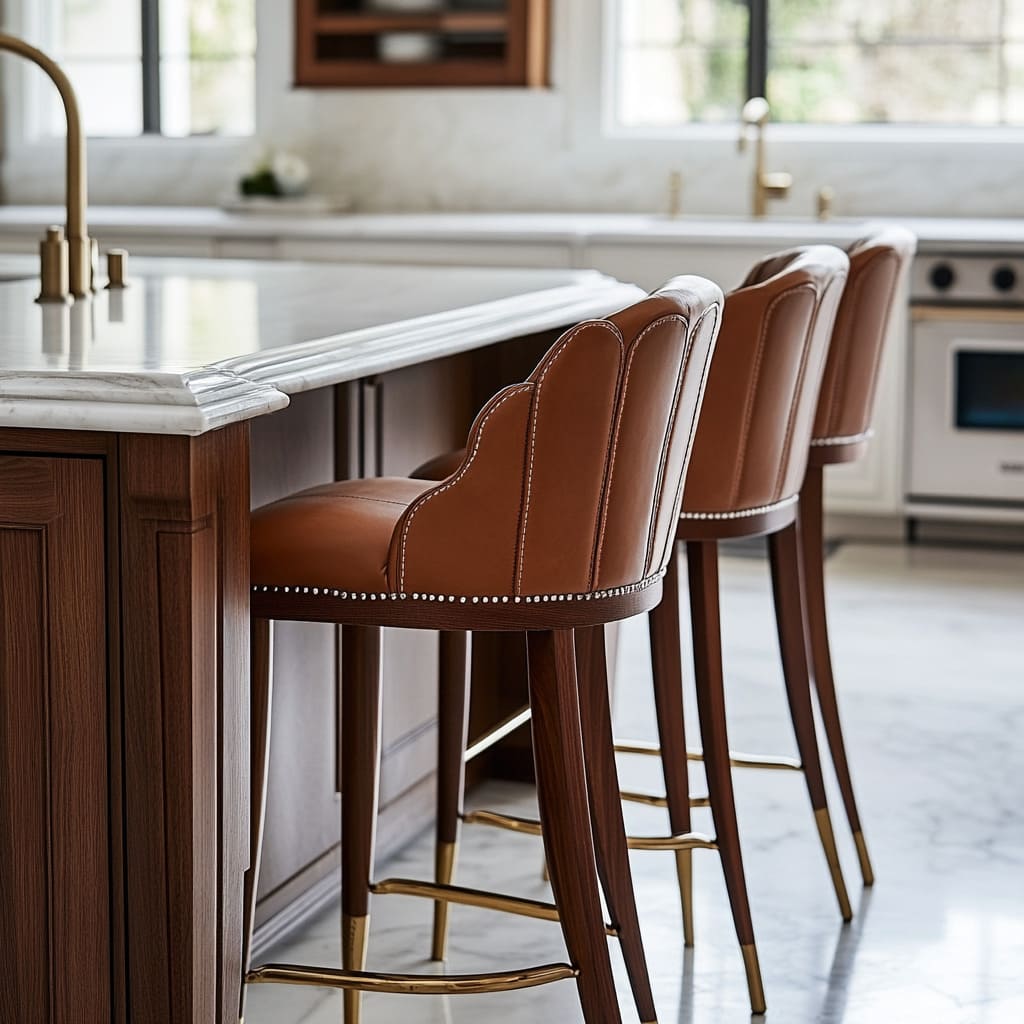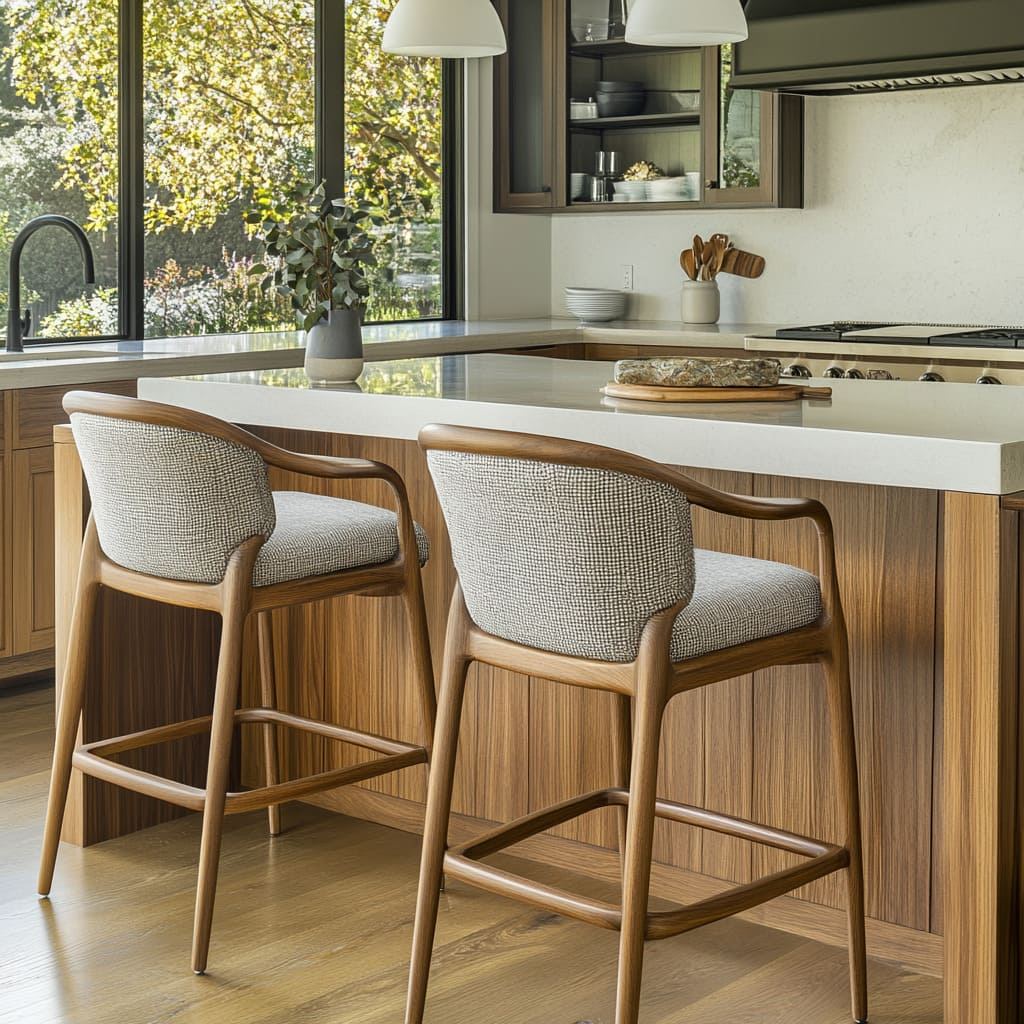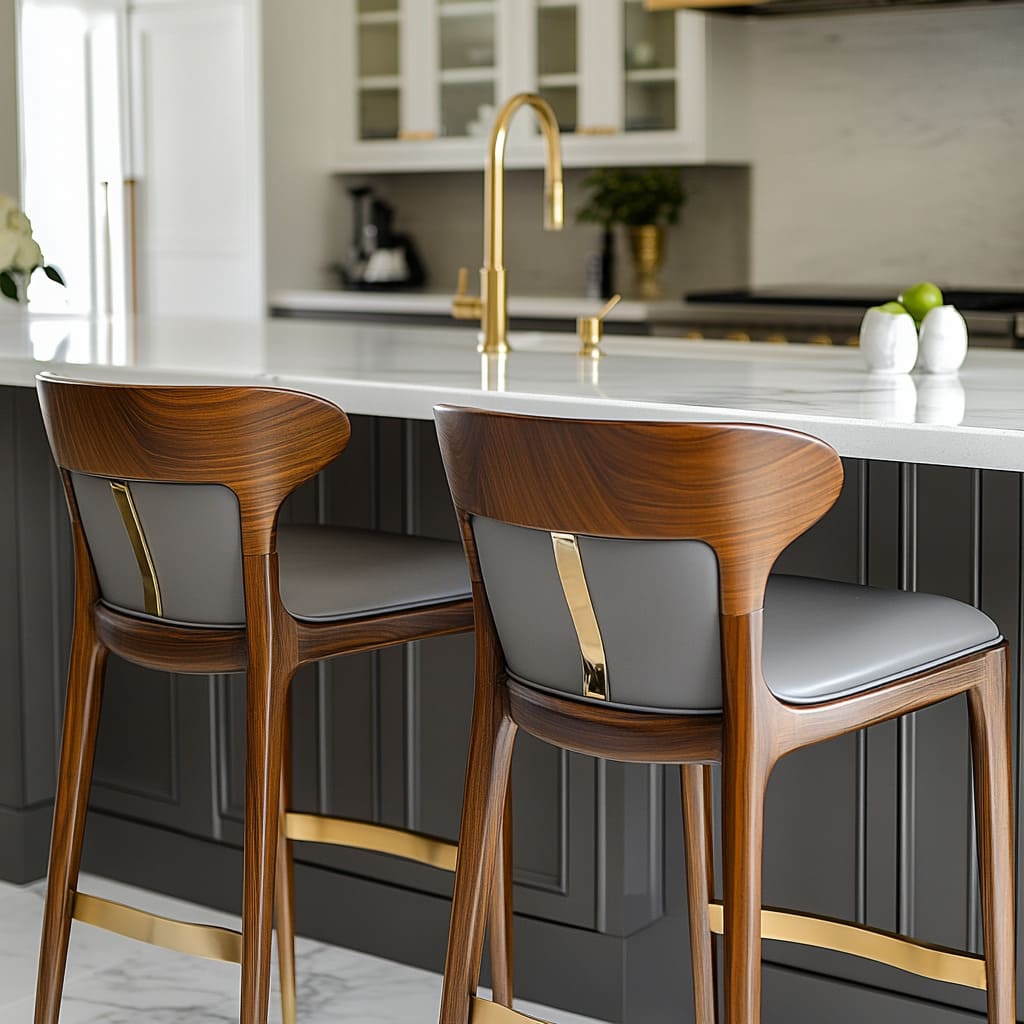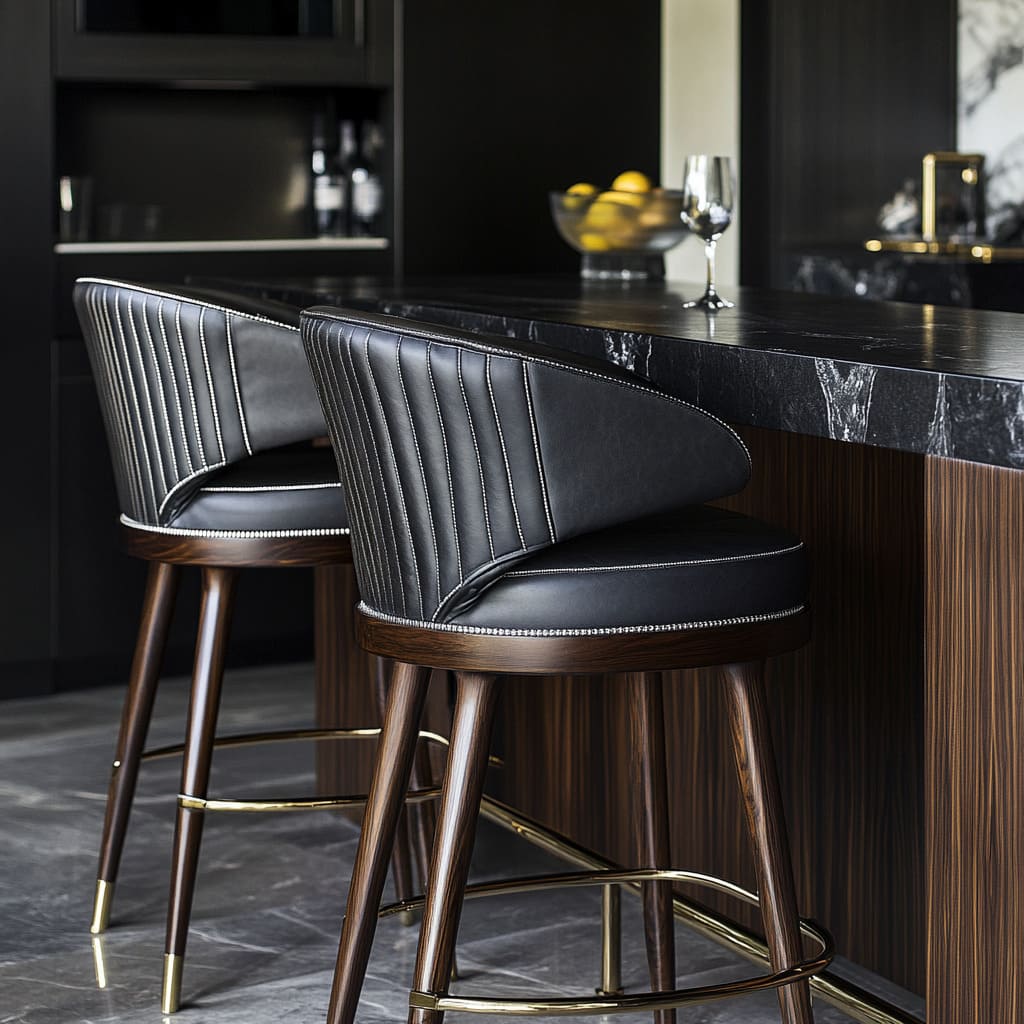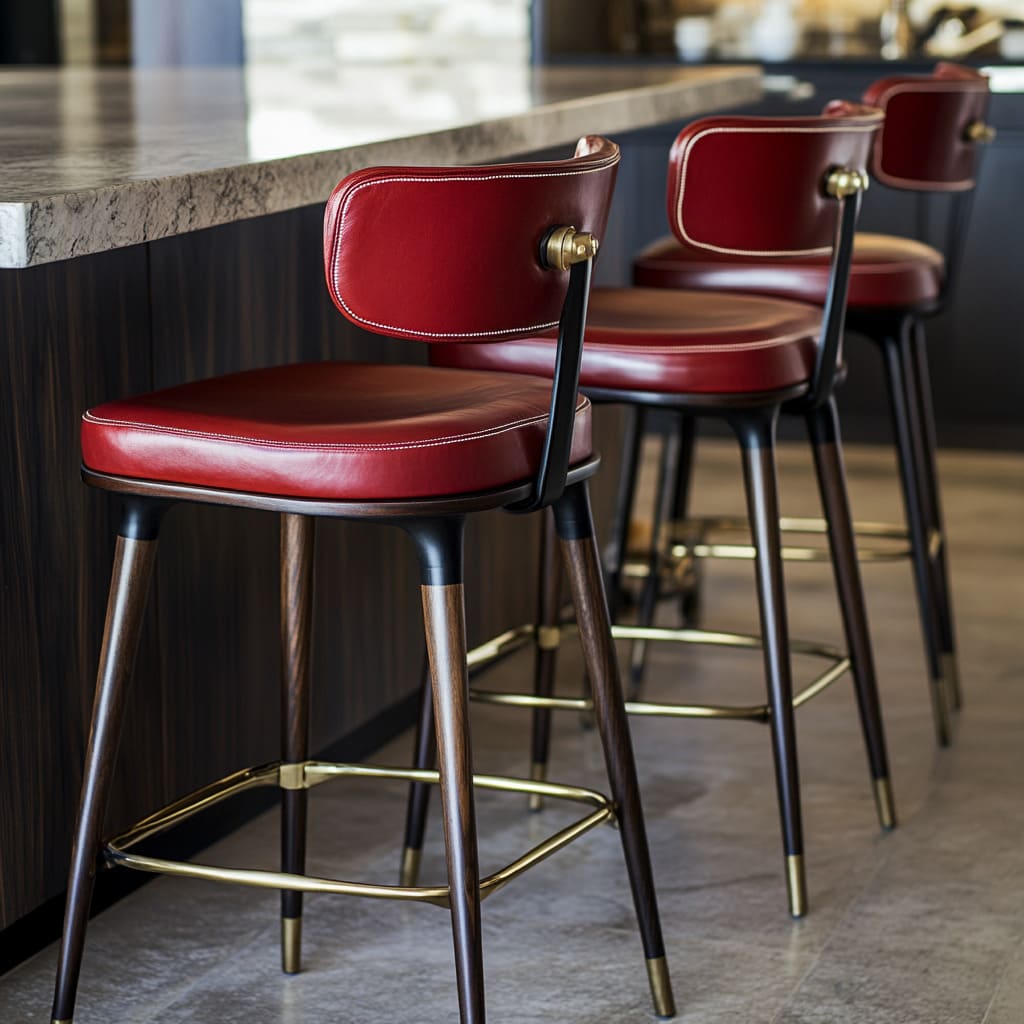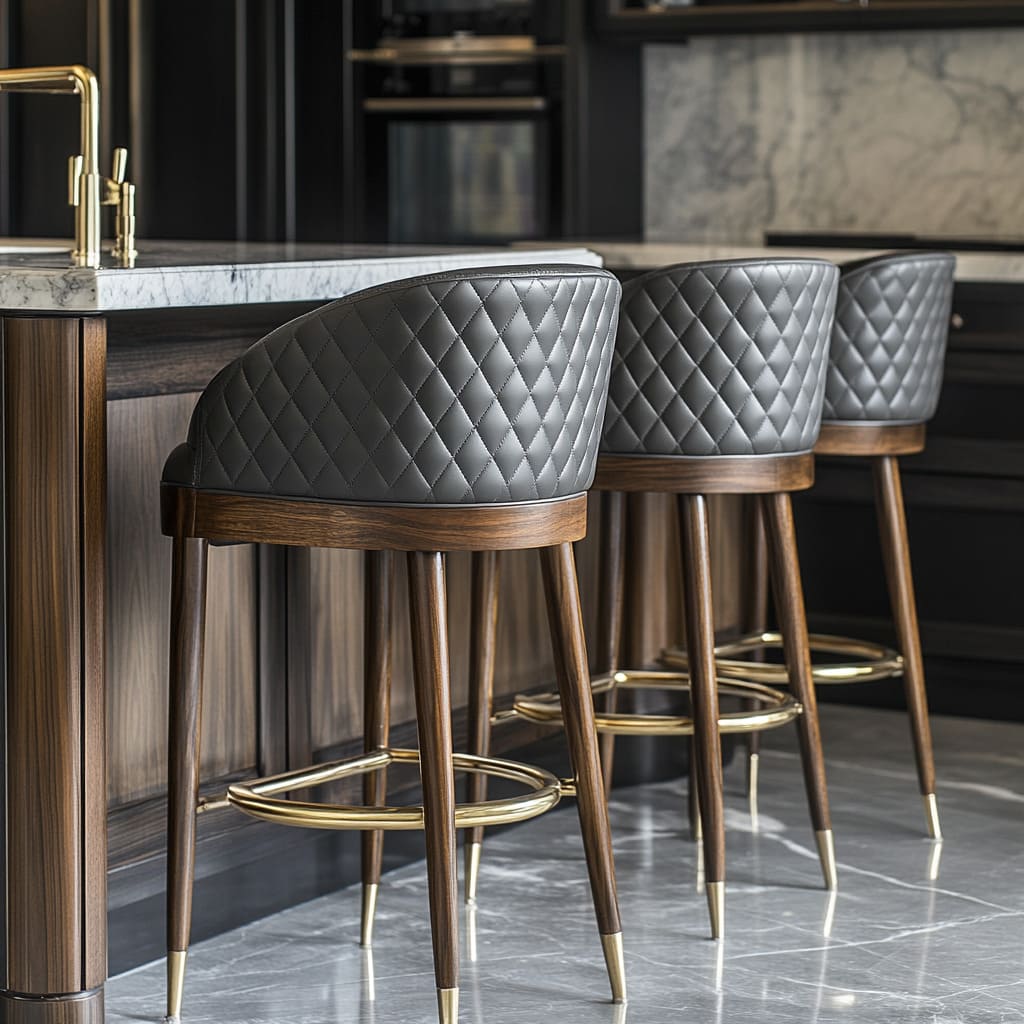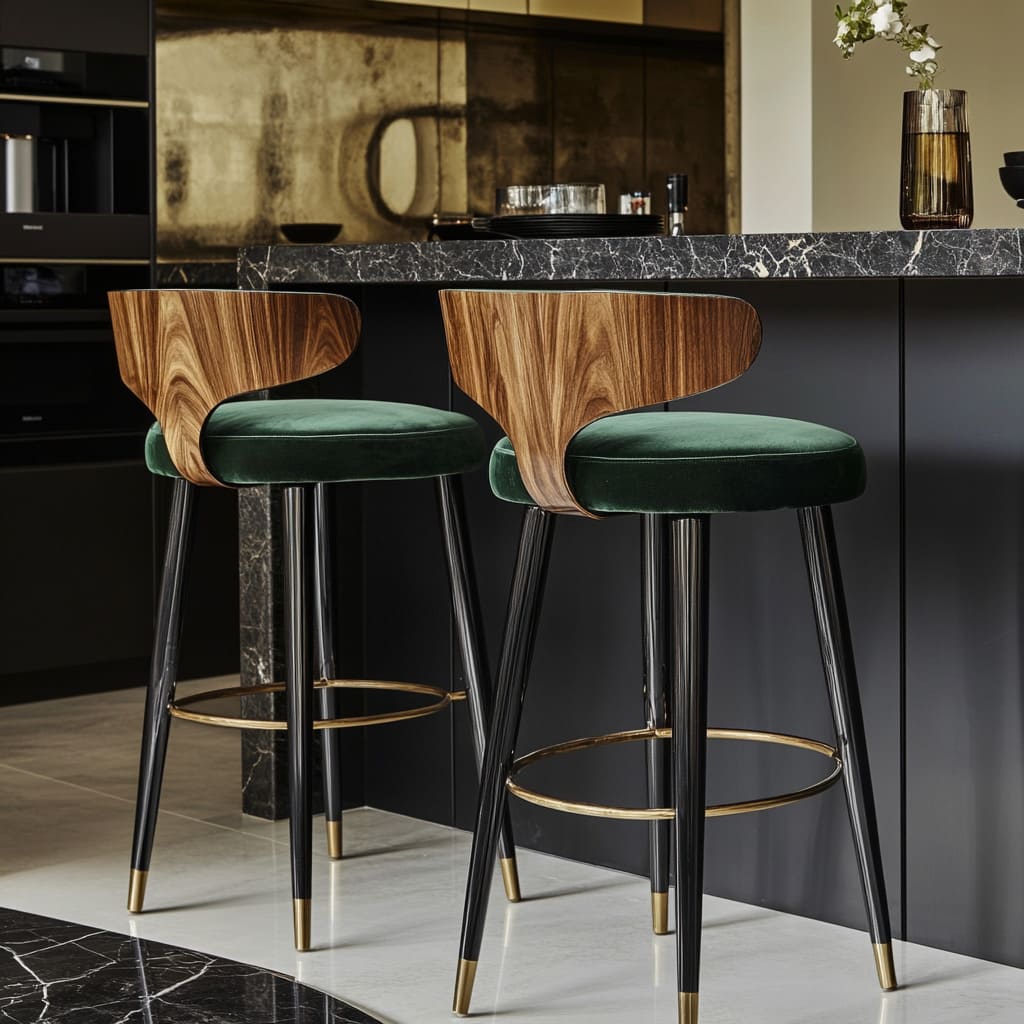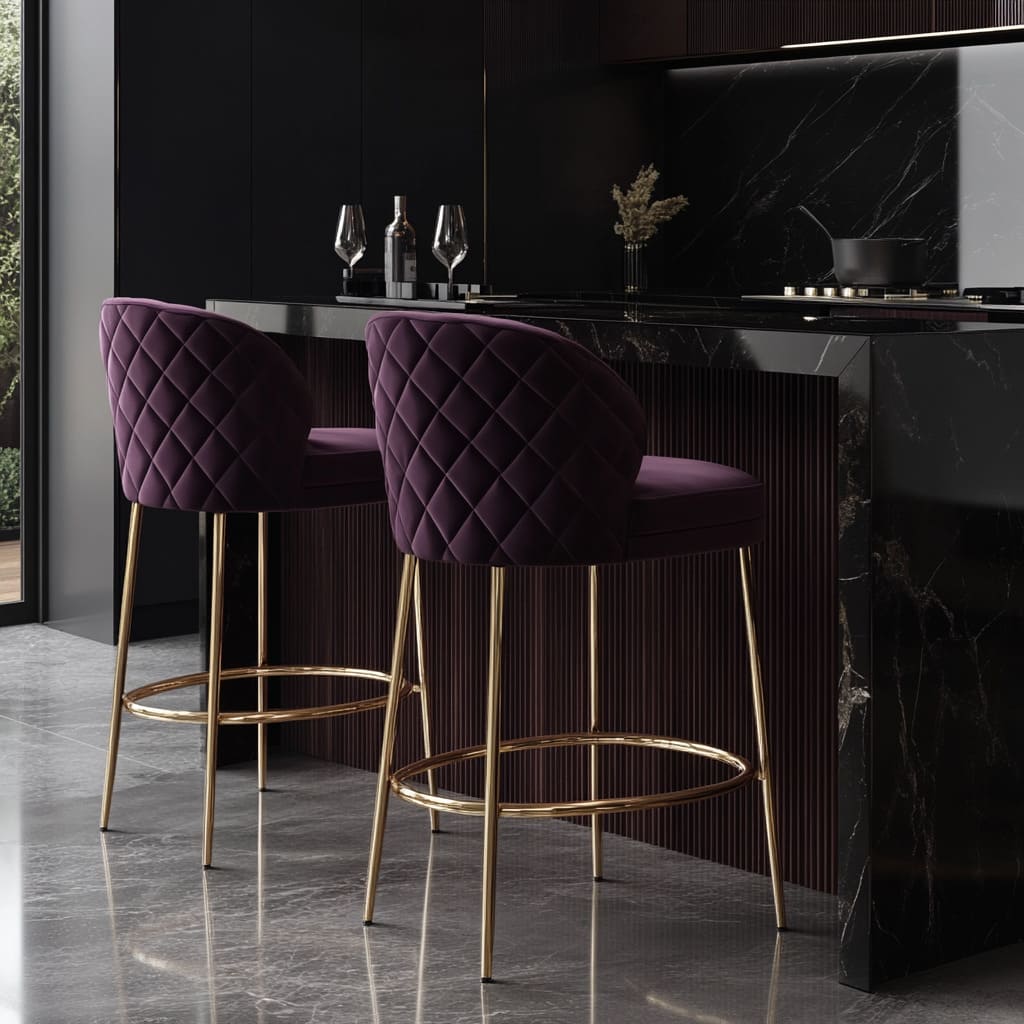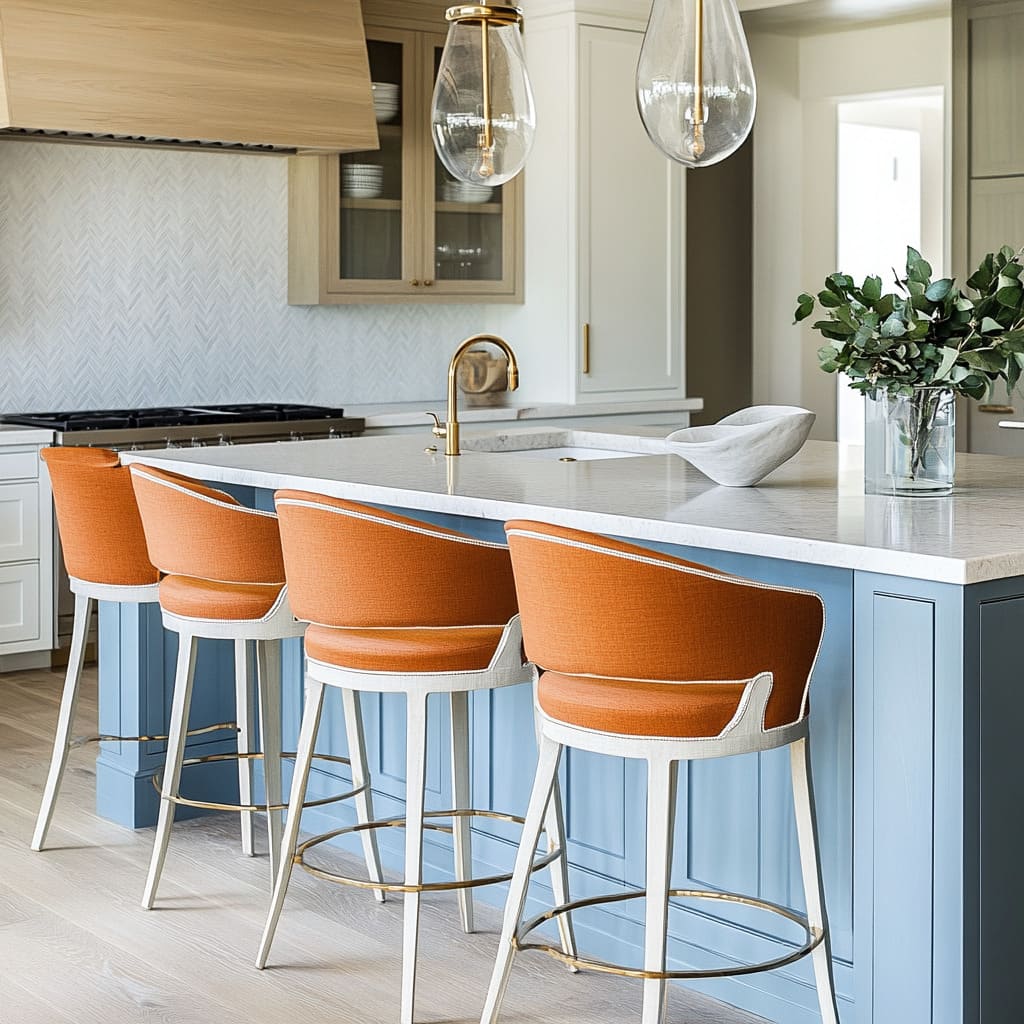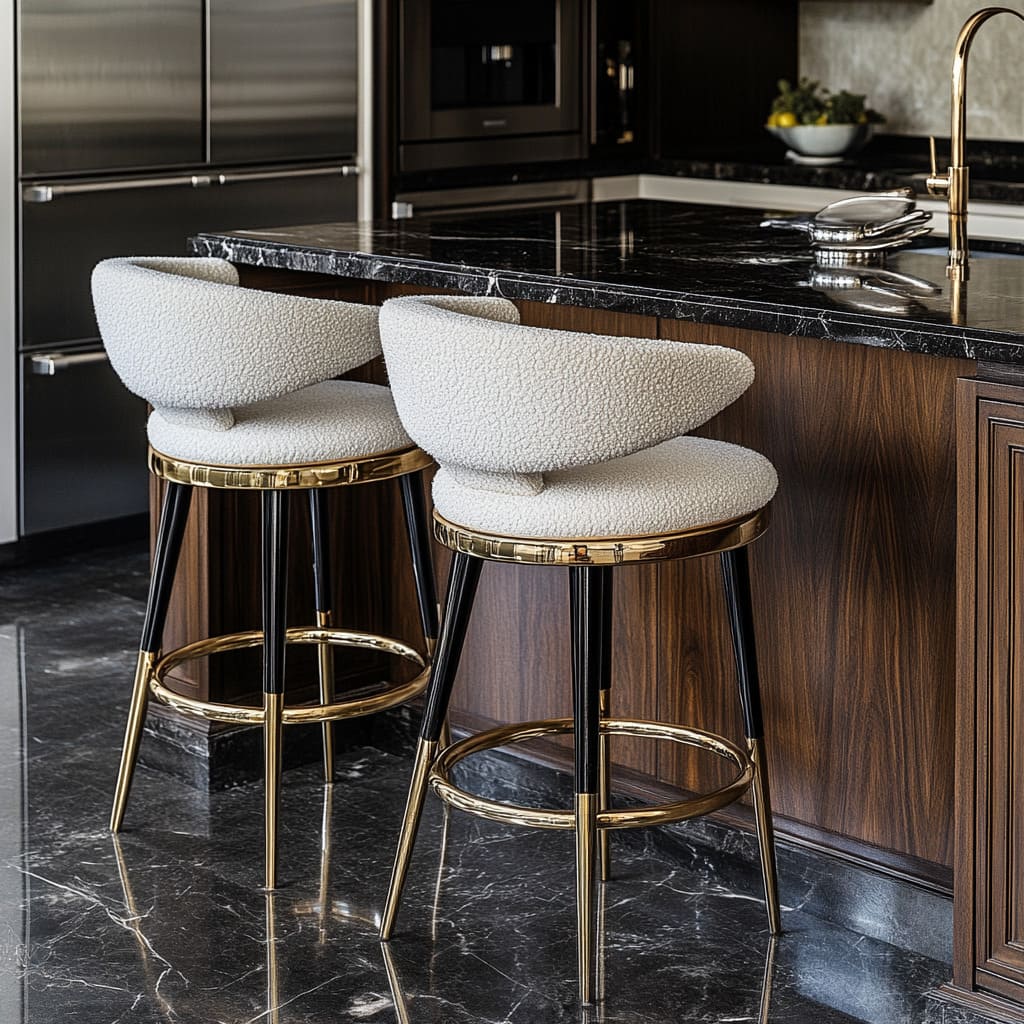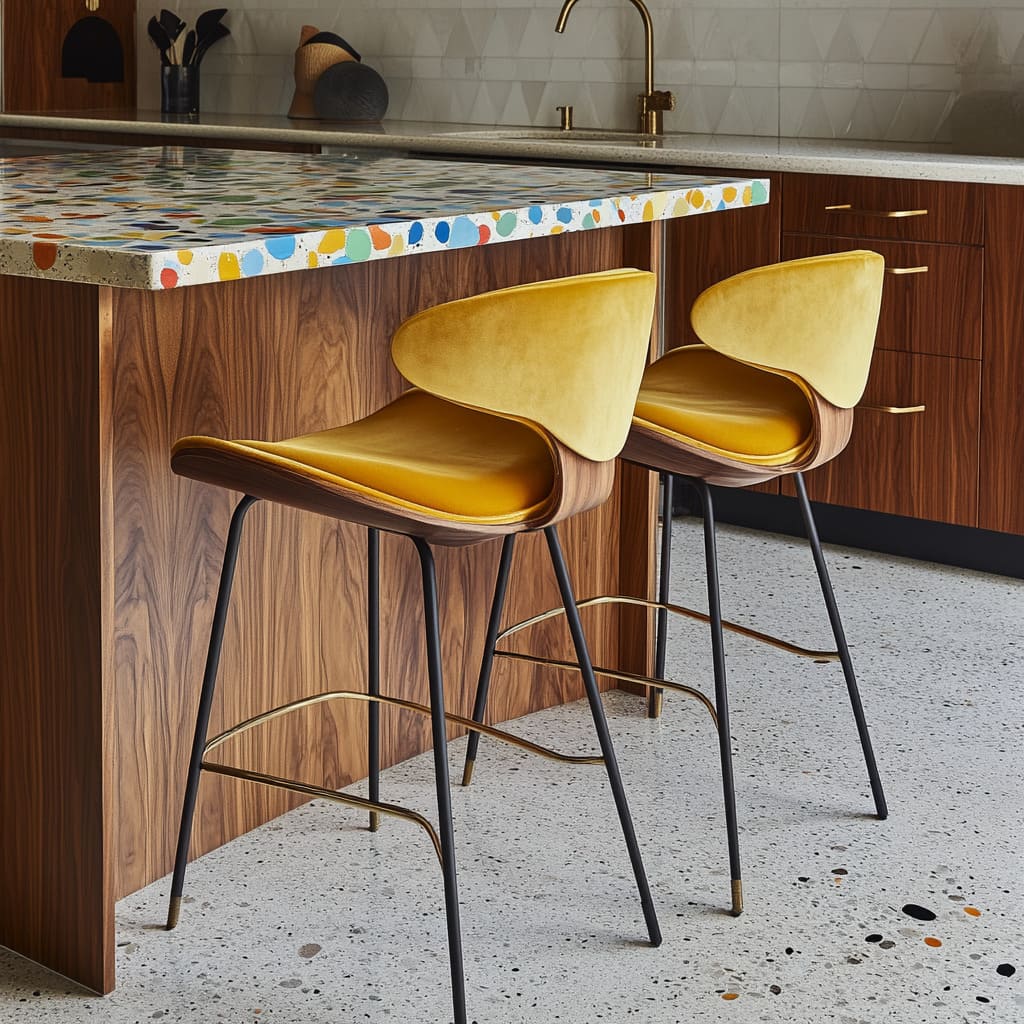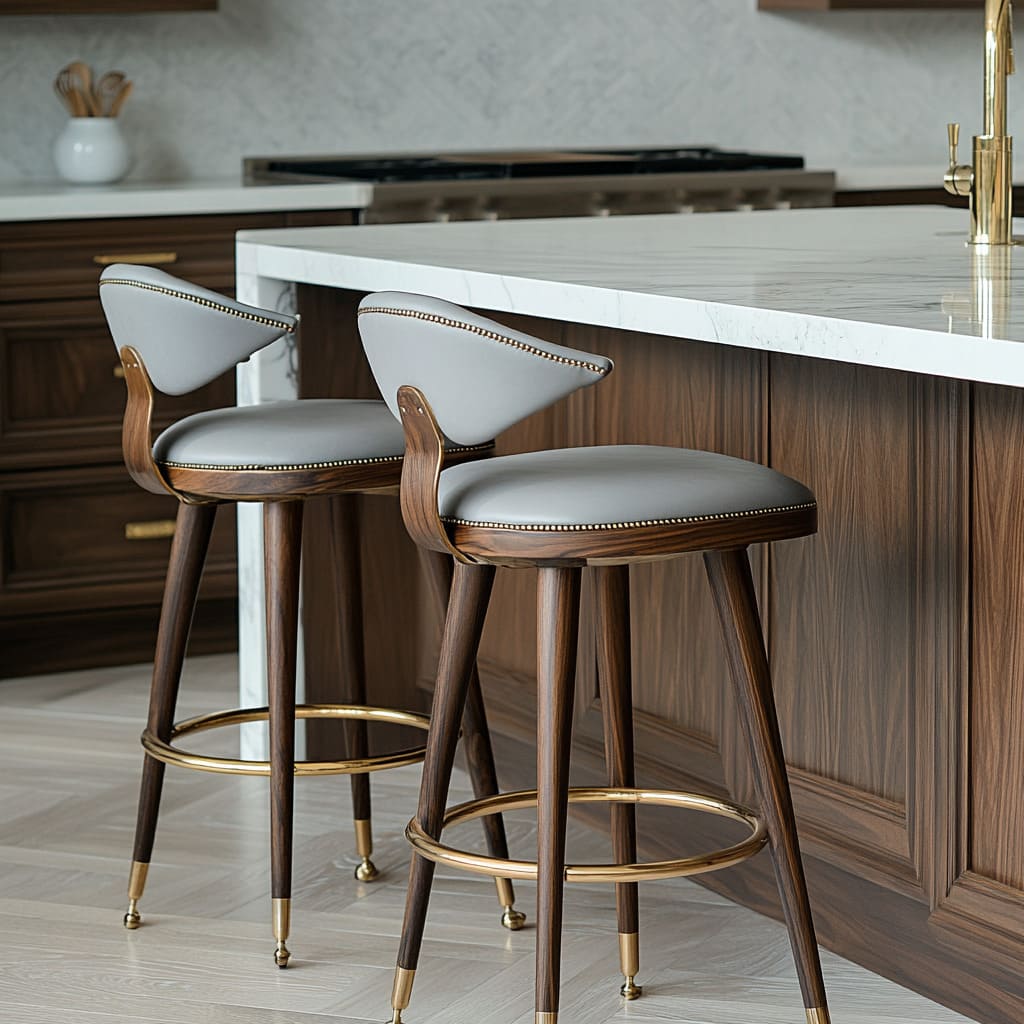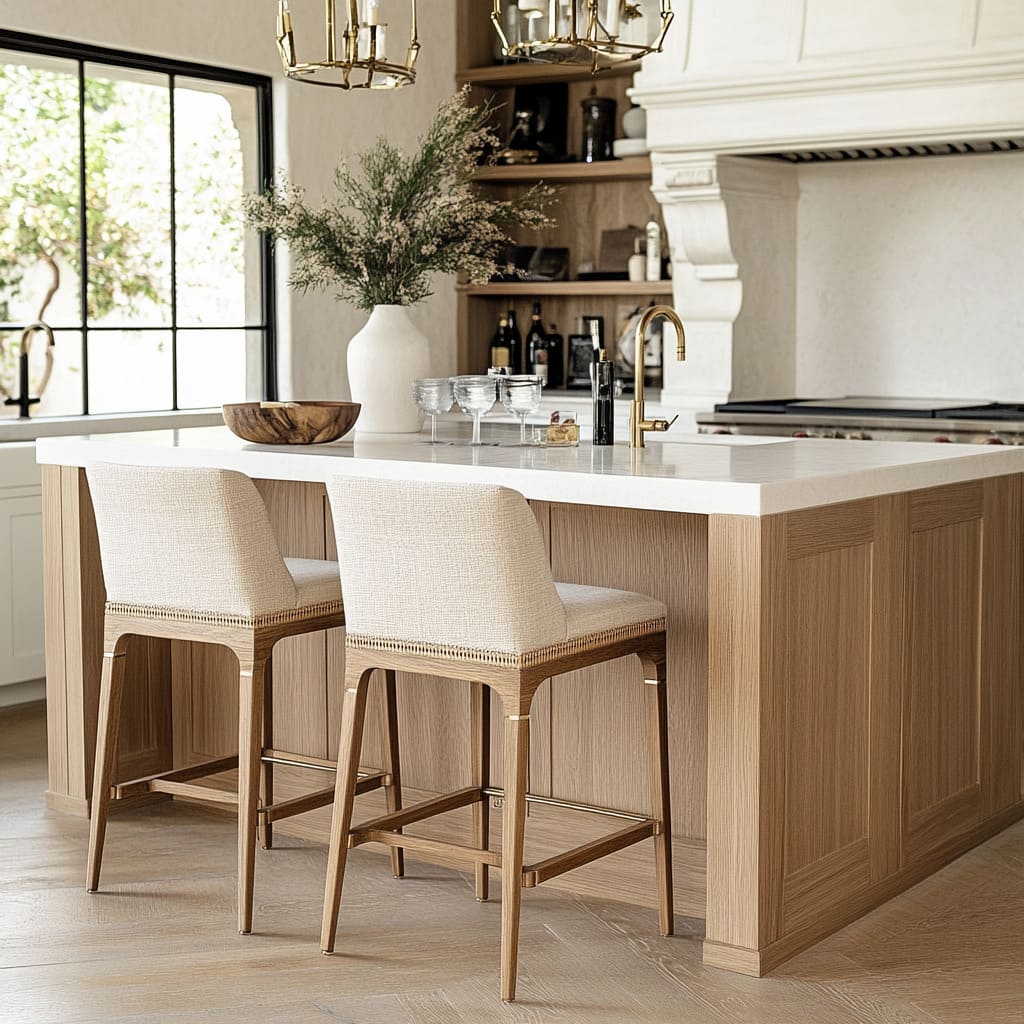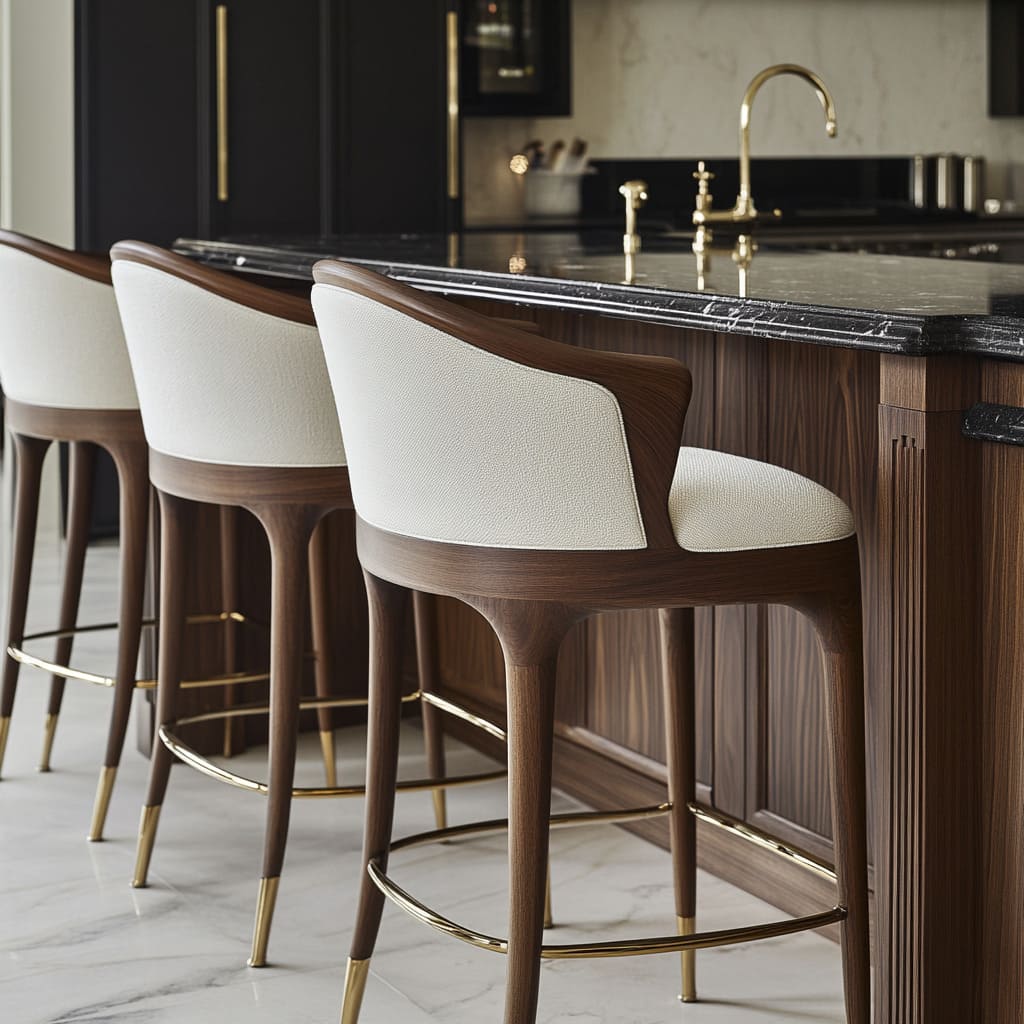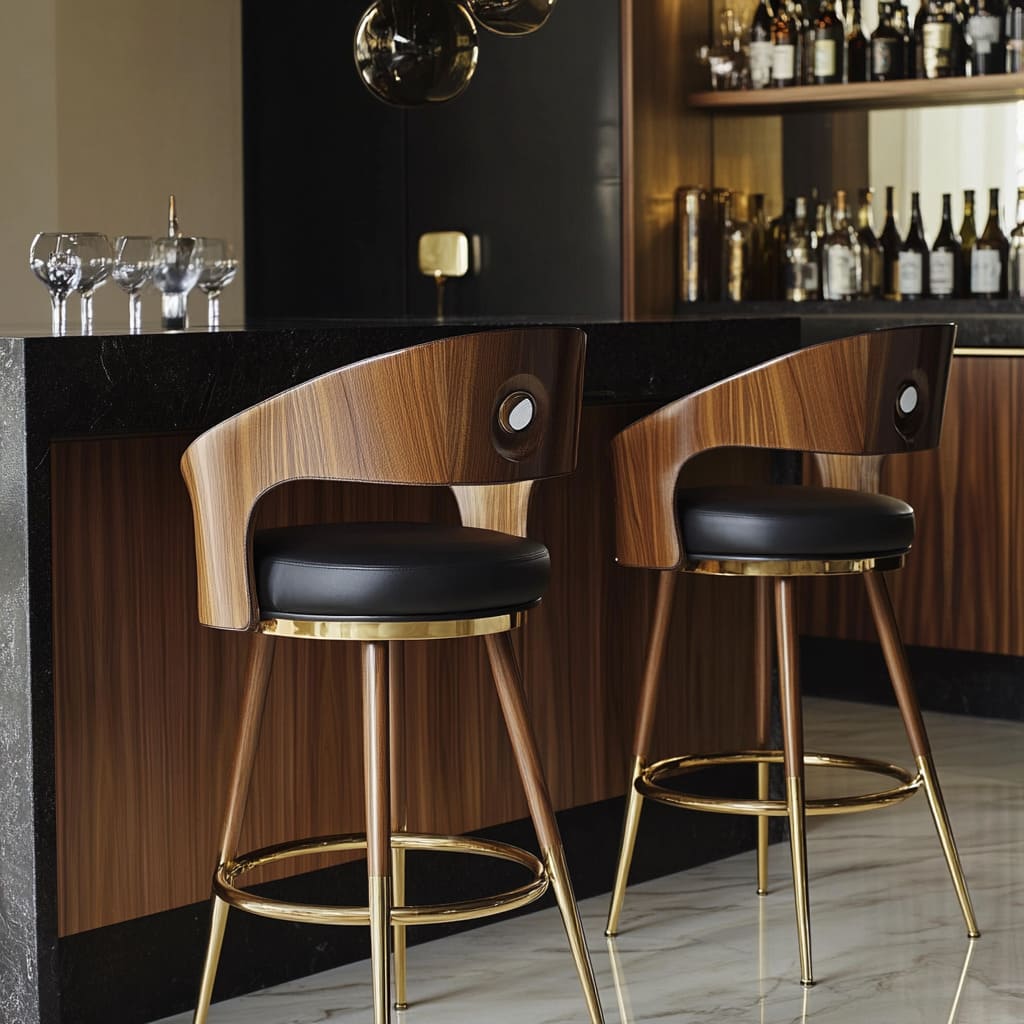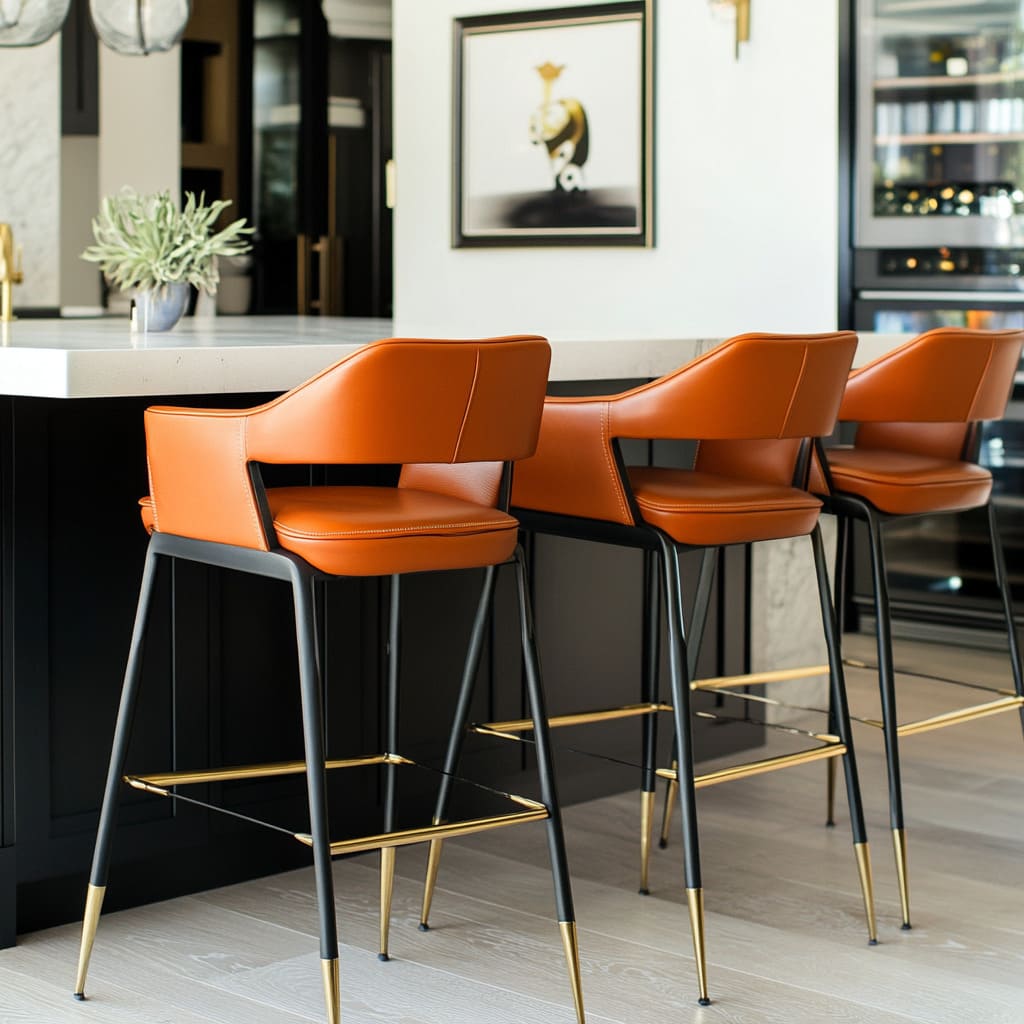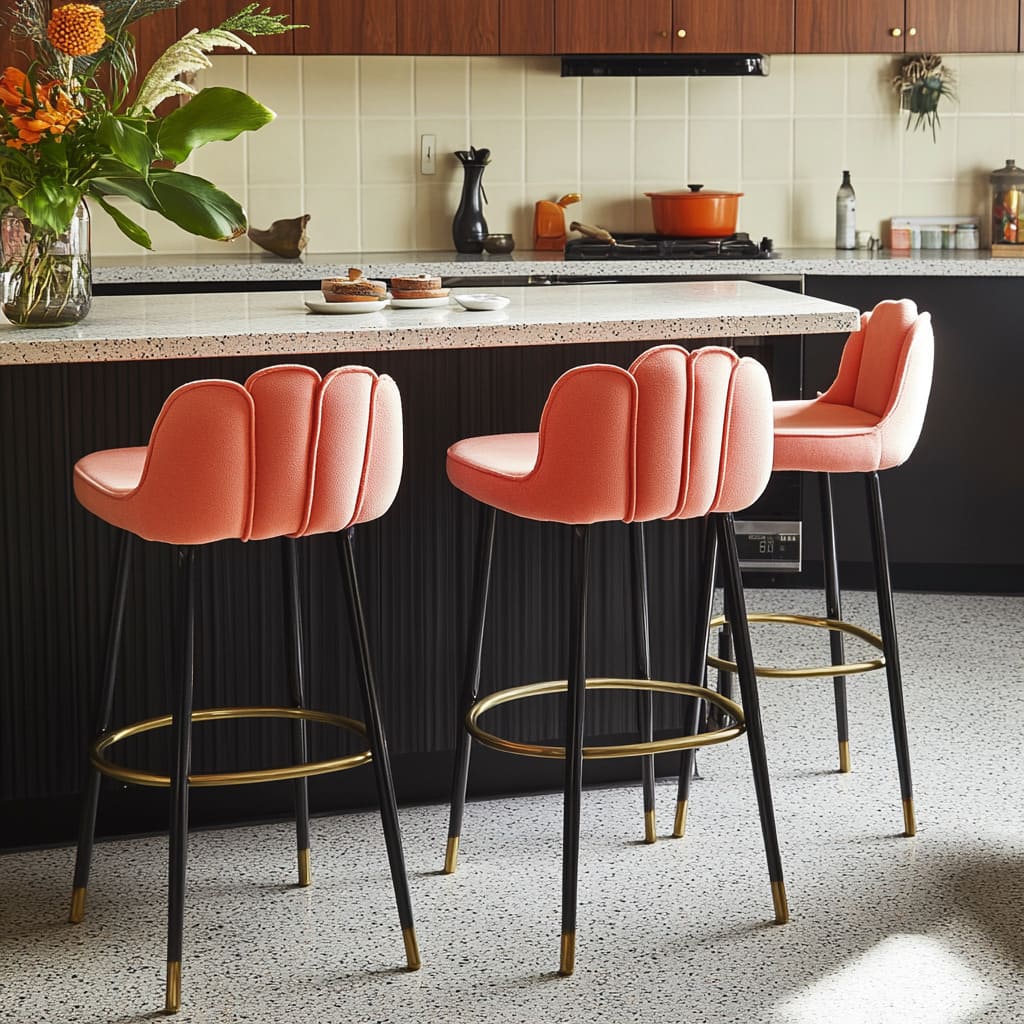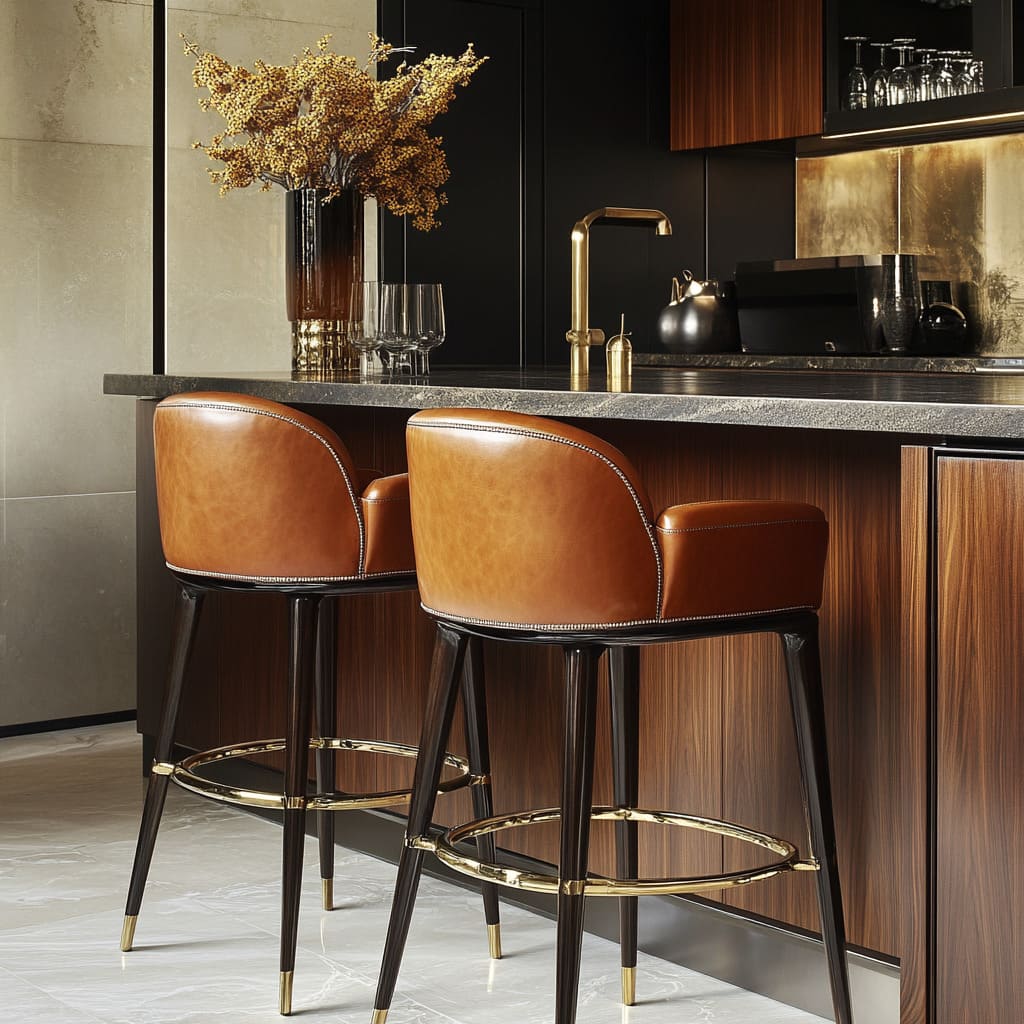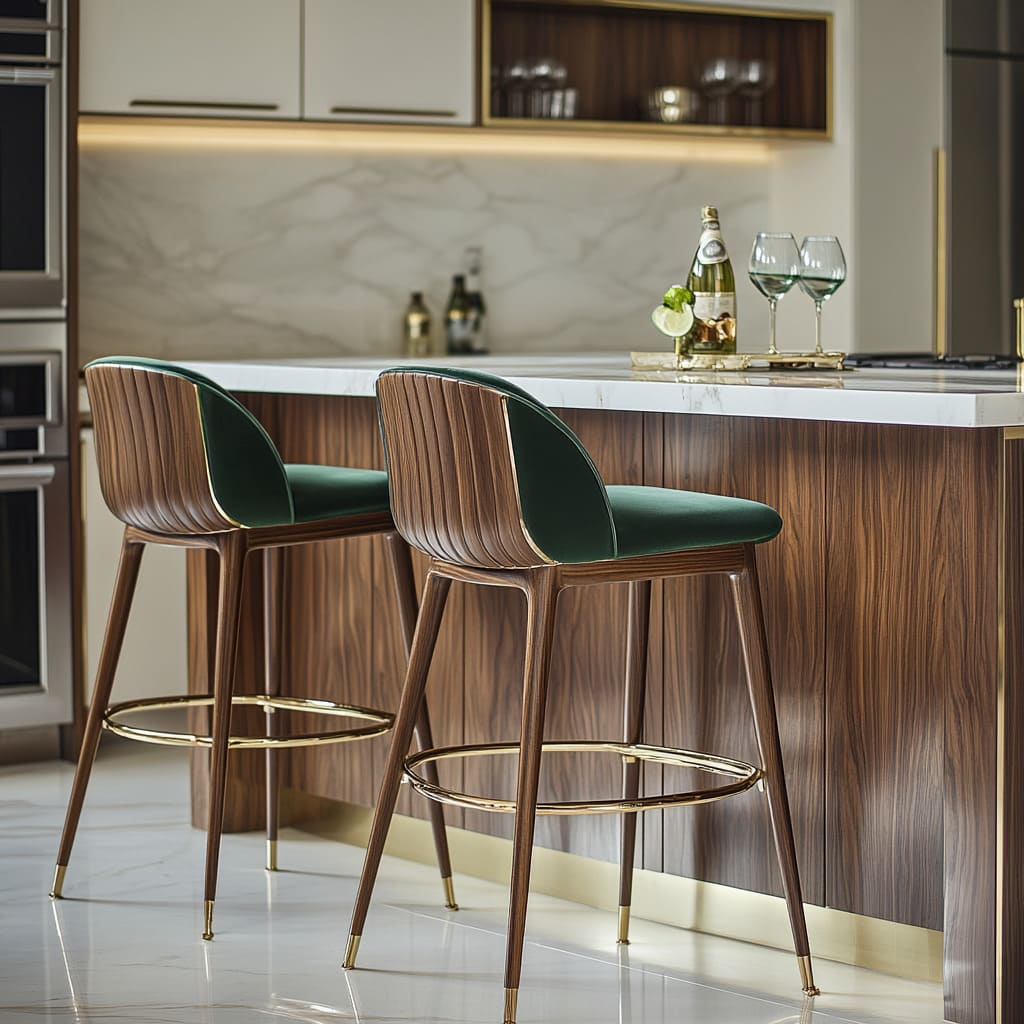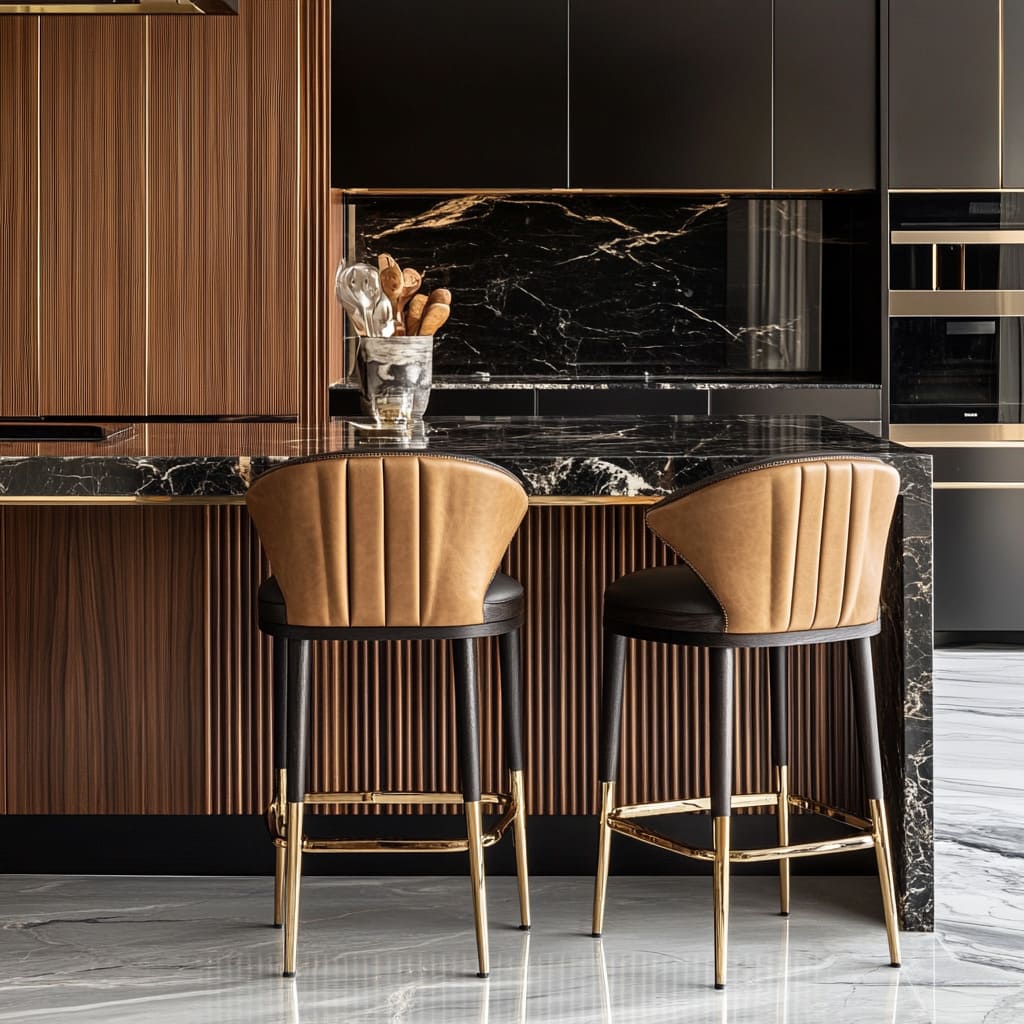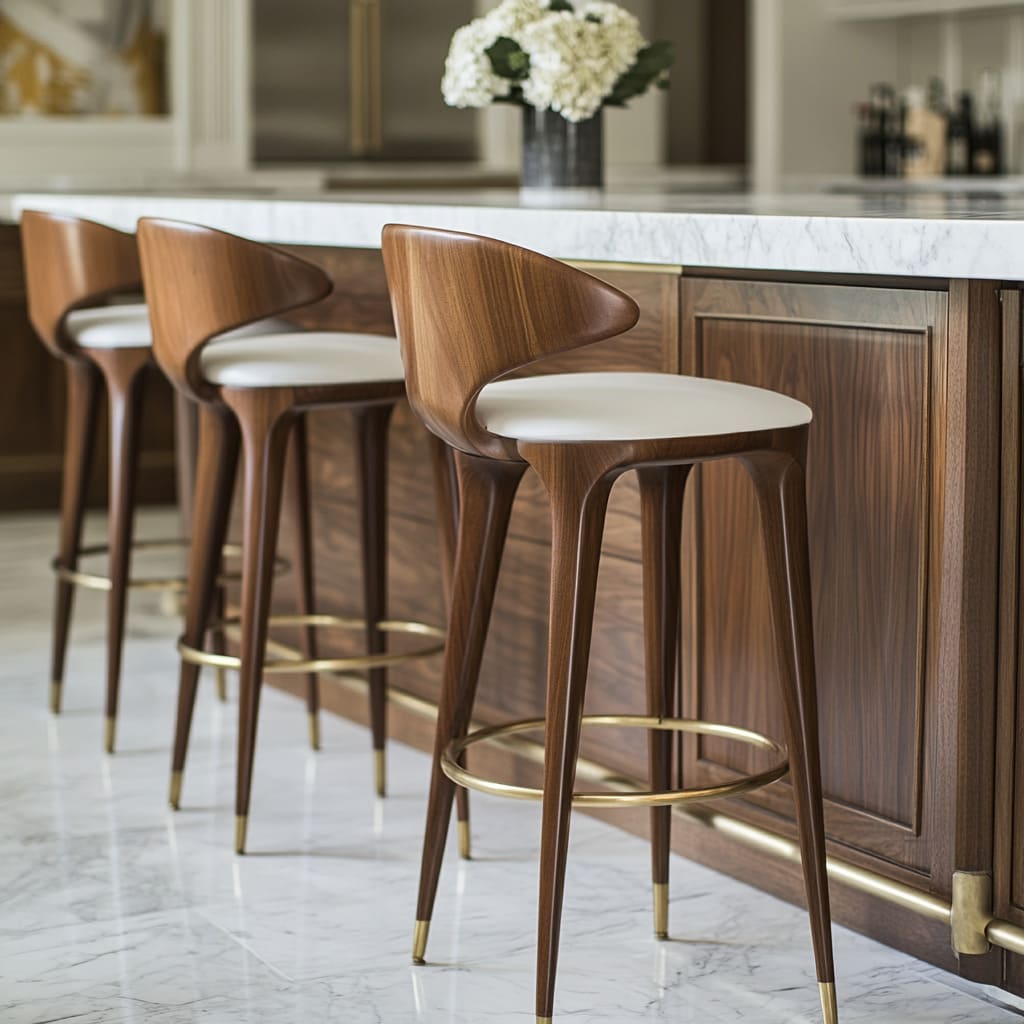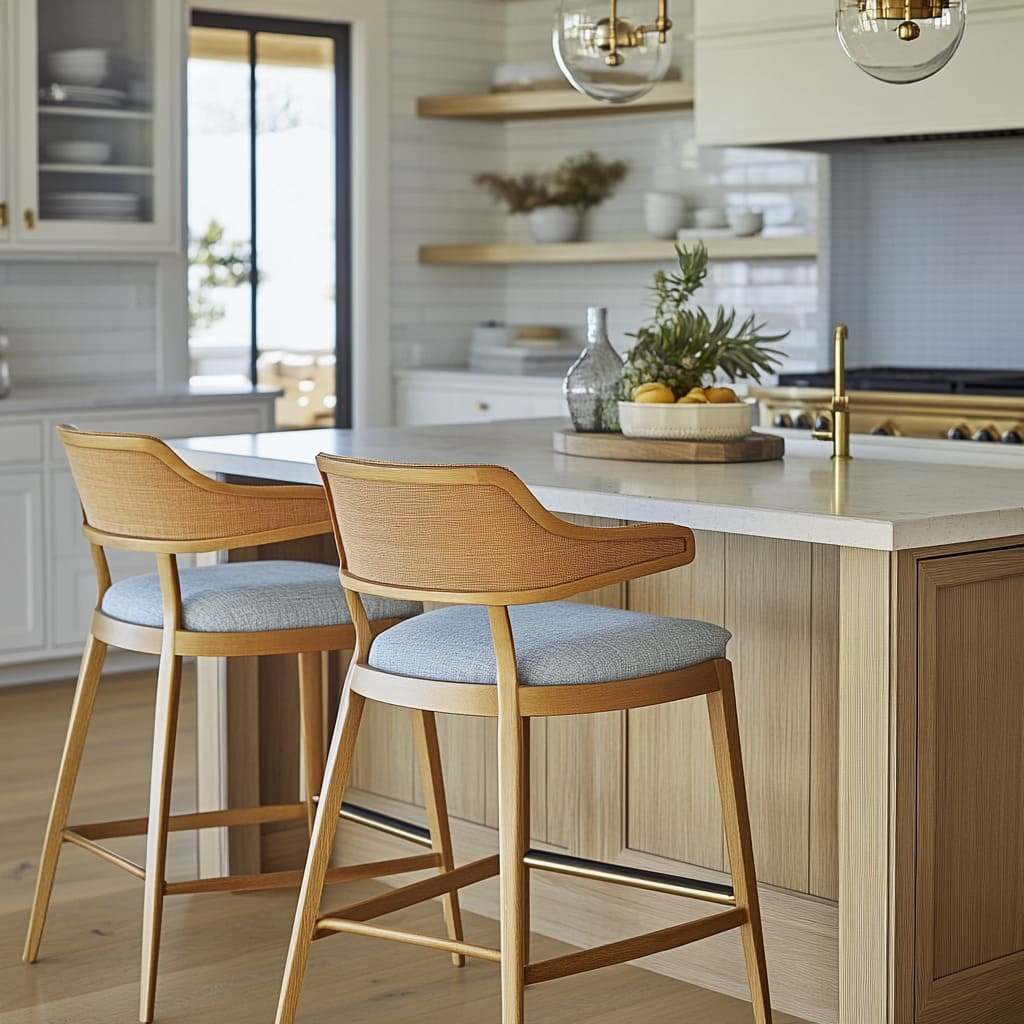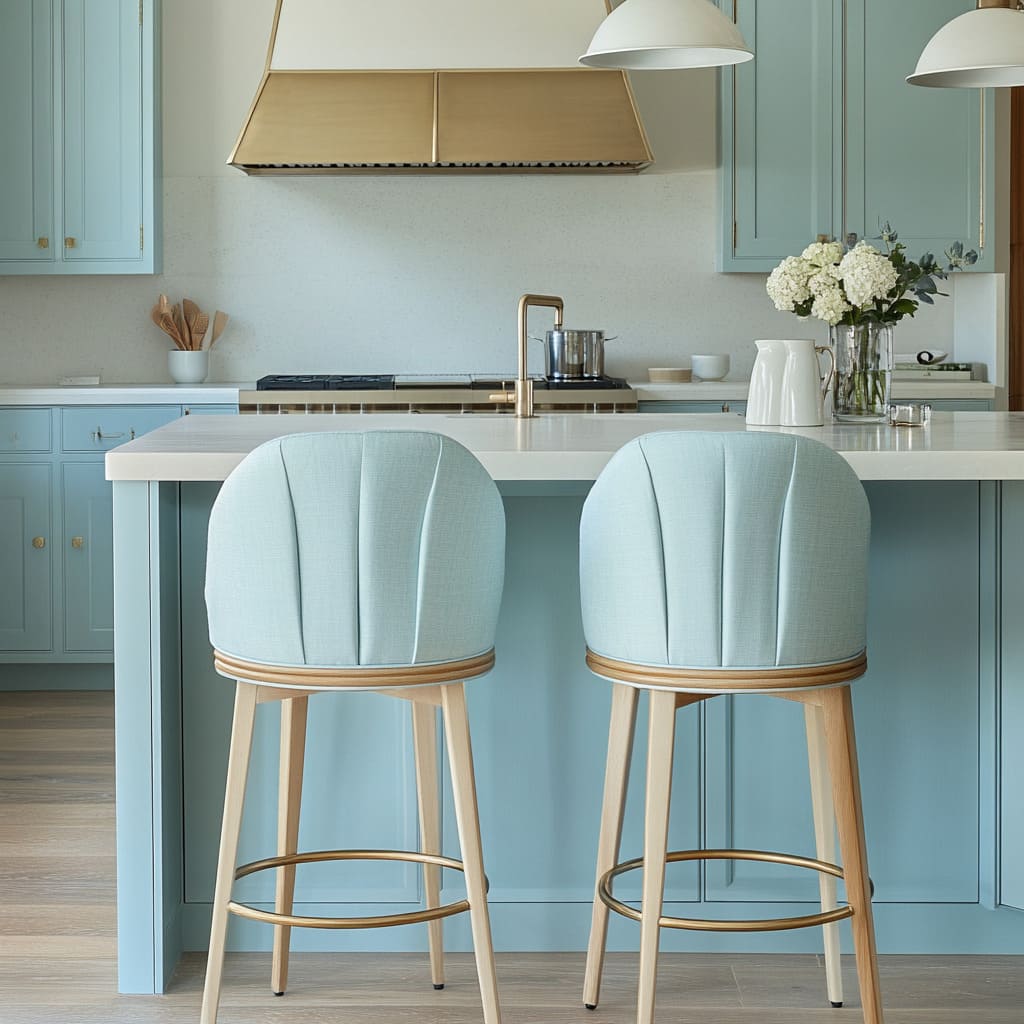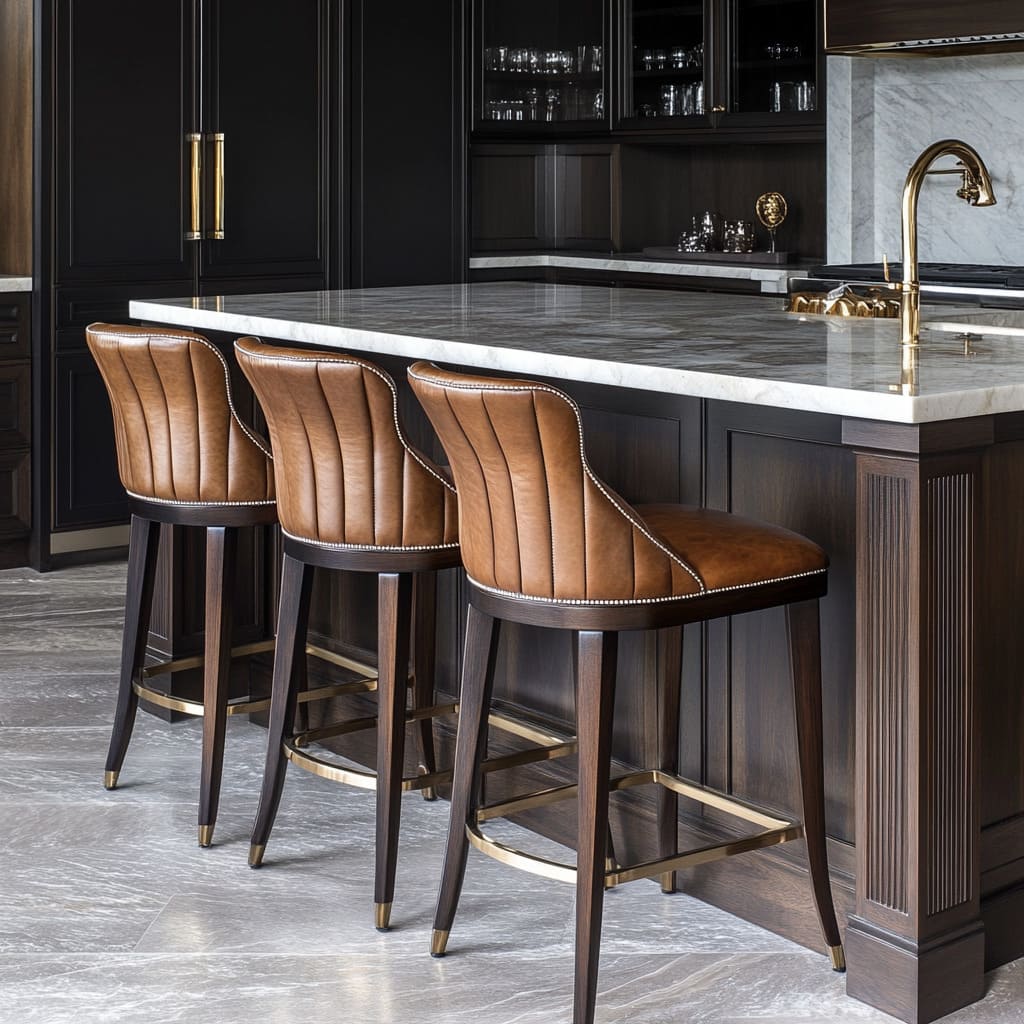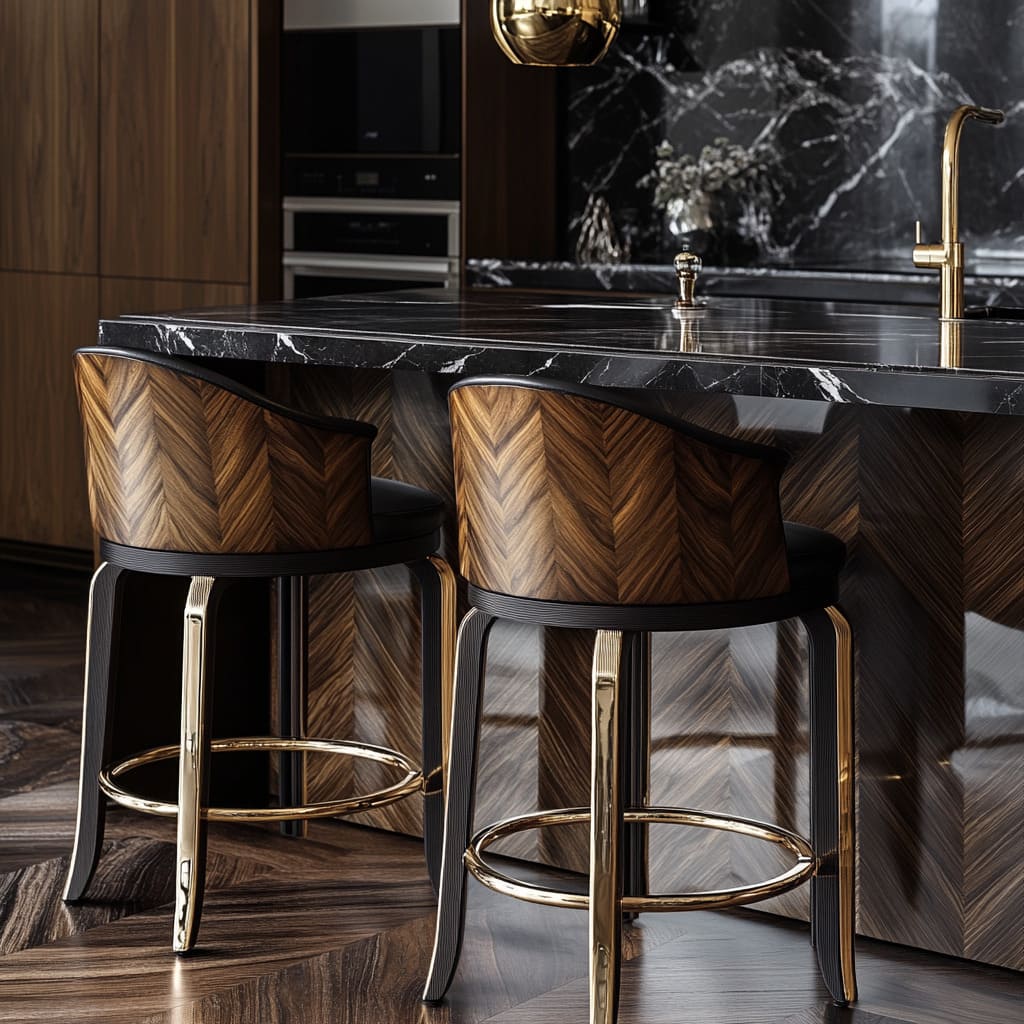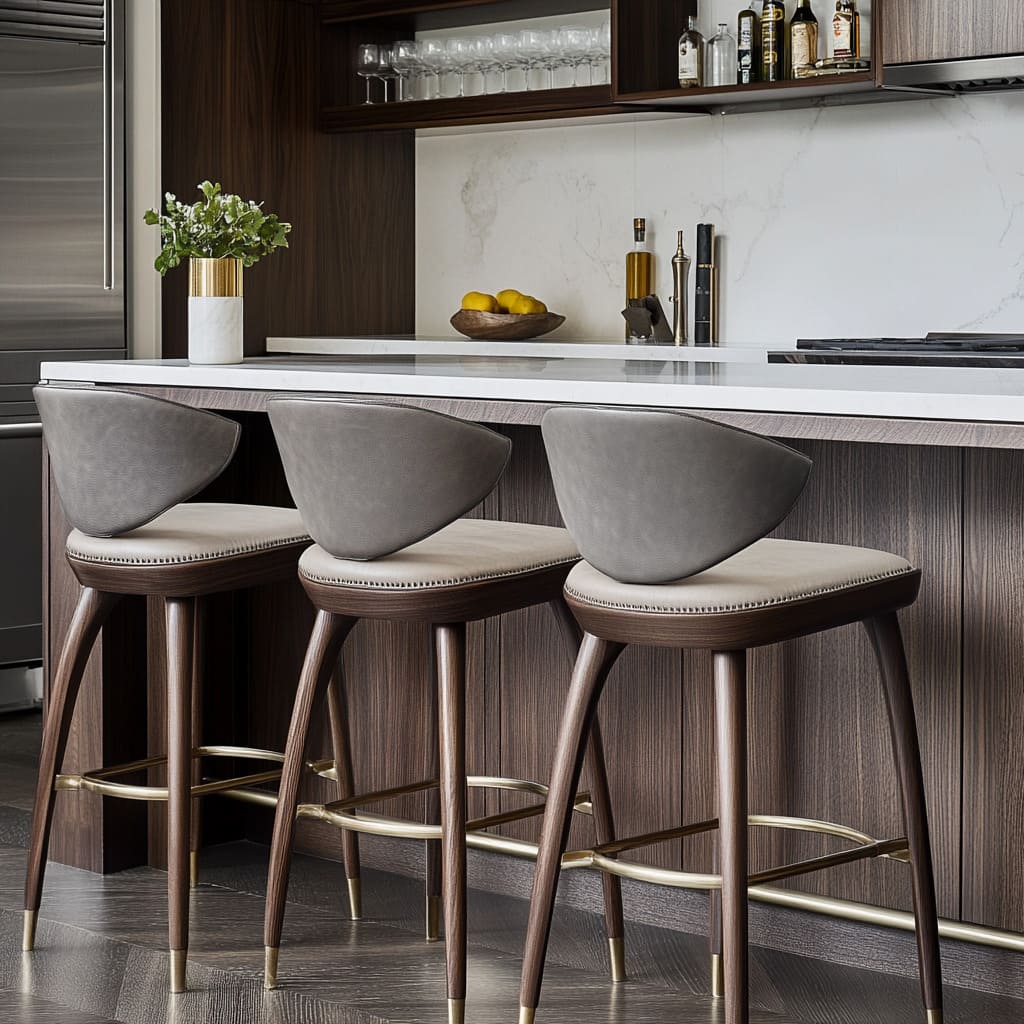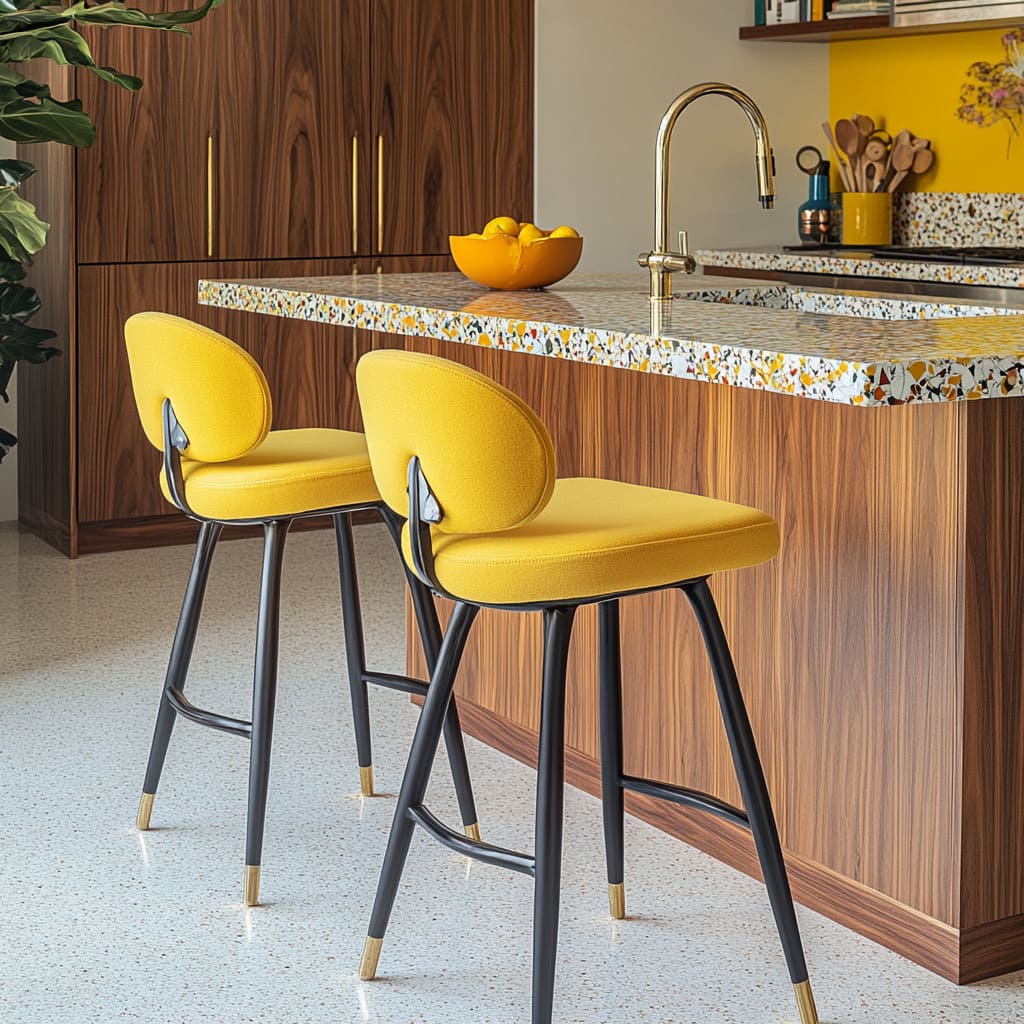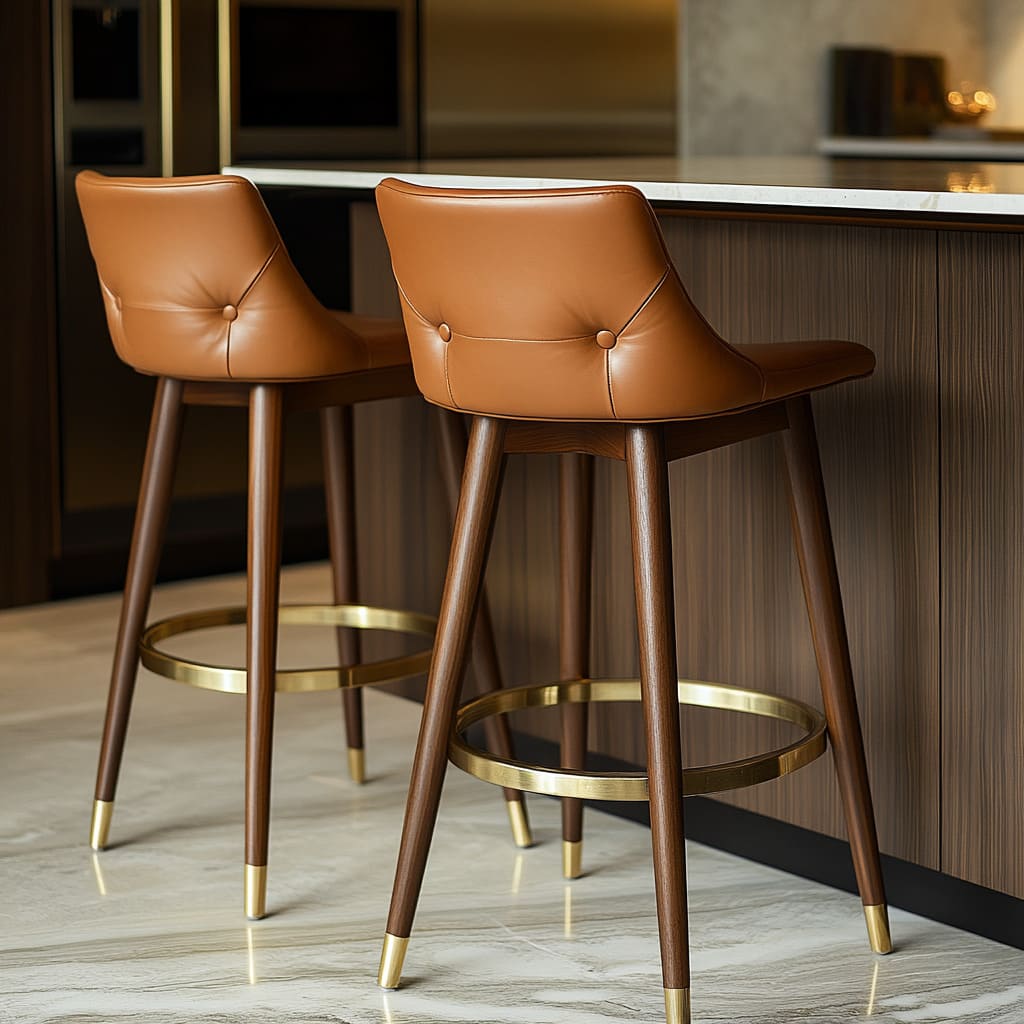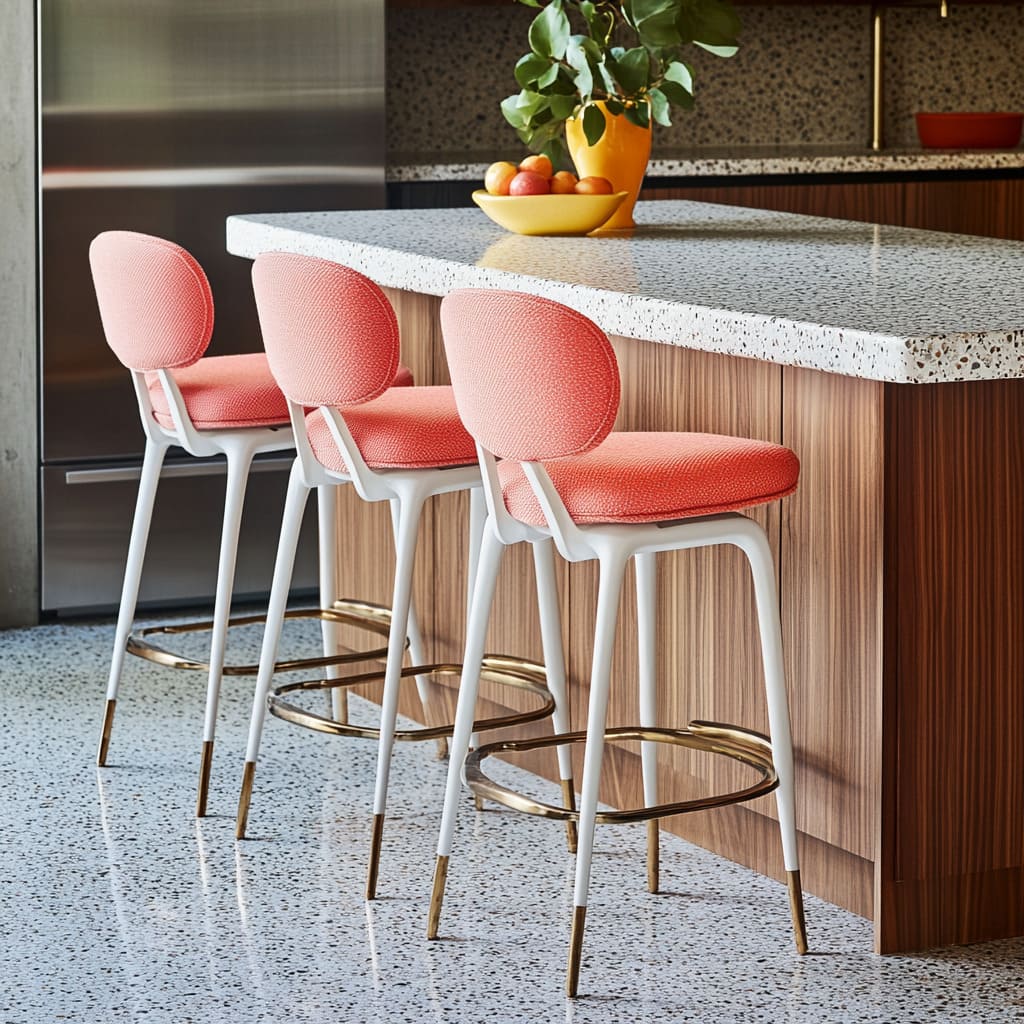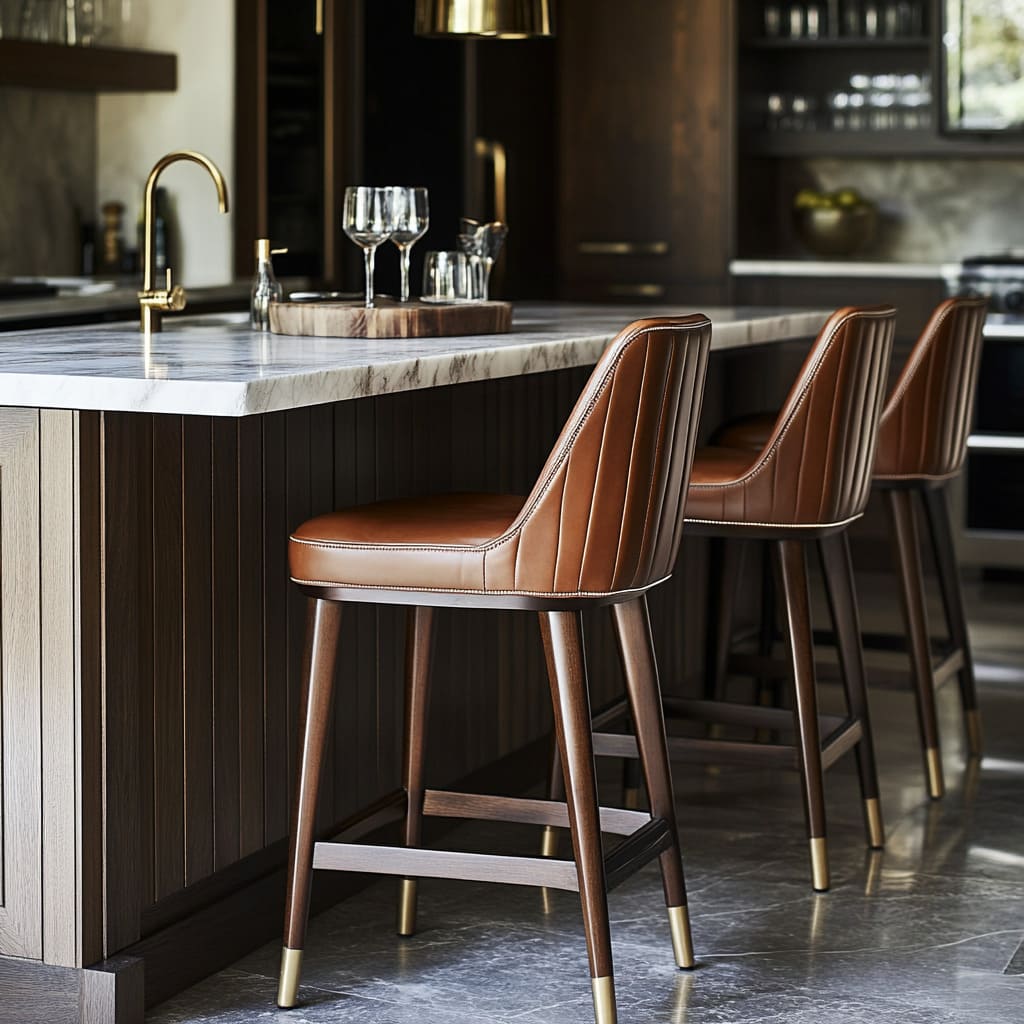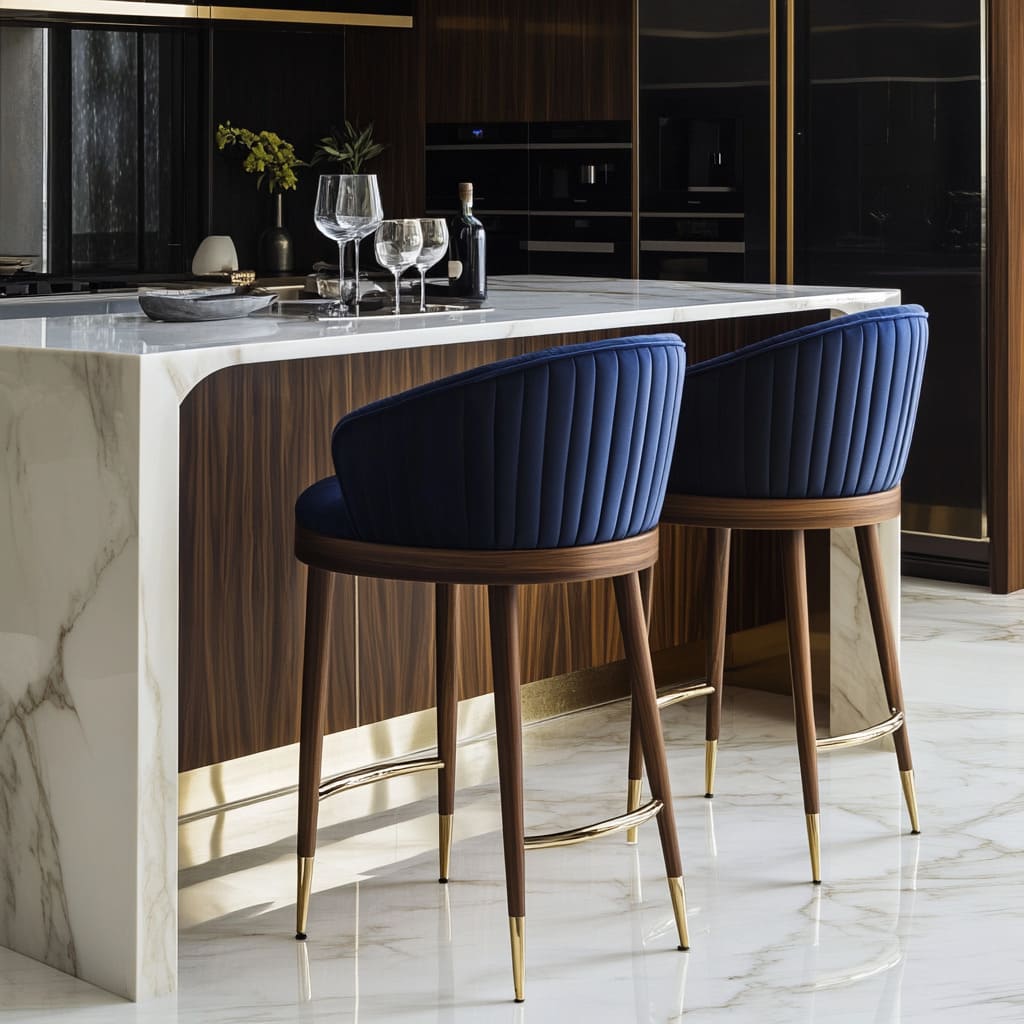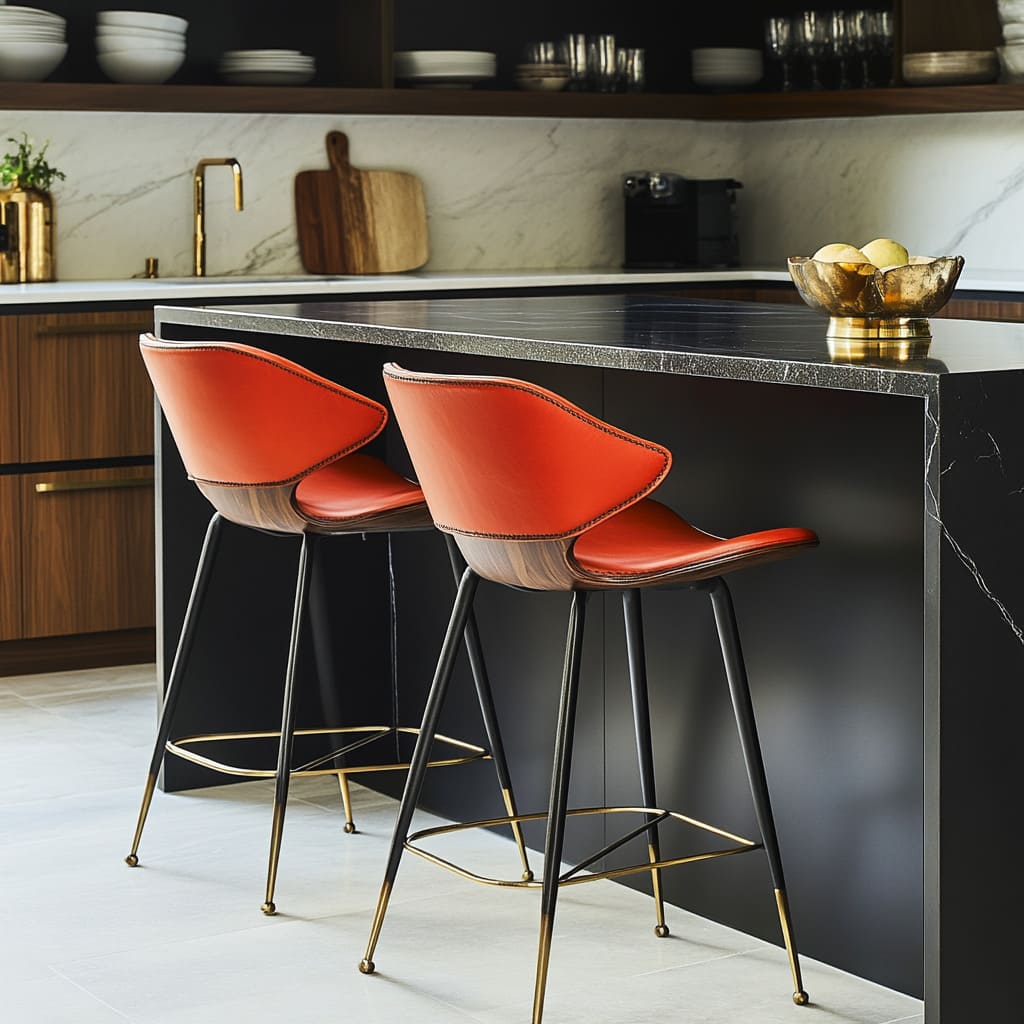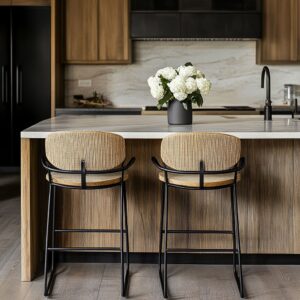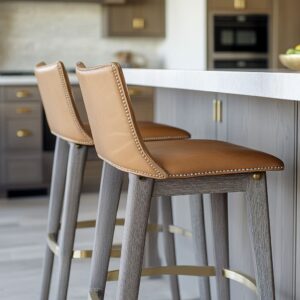When it comes to designing a kitchen that strikes the perfect balance between functionality and style, seating plays a pivotal role. Mid-century modern island counter stools offer a blend of timeless design and practical features, making them a favorite choice for homeowners looking to add character to their space.
With sleek lines, rich textures, and versatile finishes, these stools provide a unique opportunity to tie together the aesthetics of a kitchen island with the surrounding decor. Whether you’re drawn to the warmth of walnut, the pop of bold upholstery, or the gleam of brass accents, mid-century stools bring both comfort and visual interest to the heart of your home.
Dive into the following sections to uncover how these iconic designs can transform your kitchen into a space that feels both cohesive and inspired.
Material Contrasts and Synergy
When exploring mid-century modern bar stools ideas, the interplay of materials stands out as a key design element. This approach brings depth and character to kitchens, blending traditional and contemporary influences in ways that feel both refined and visually dynamic.
Warm Woods and Metals
A consistent theme across these designs is the use of walnut, a material celebrated for its rich grain and warm tones. Its presence is most noticeable in curved backrests, tapered legs, and sometimes even in island paneling.
Walnut creates a striking contrast when paired with lighter upholstery or brighter kitchen elements, serving as an anchor that ties the room together.
Brass details further enhance these compositions. Frequently featured on footrests, leg caps, hardware, and faucets, brass offers both warmth and a touch of sophistication.
It works harmoniously with walnut and darker elements, like black marble countertops or black metal frames, adding a hint of brightness without overpowering the overall palette. For an extra layer of interest, some designs embrace mixed metals.
Examples include white frames accented with gold, black frames tipped with brass, and matte black hardware offset by brushed brass finishes. These combinations add complexity and dimension, particularly when paired with bold upholstery colors such as emerald, coral, or vibrant yellow.
Leather, Bouclé, and Velvet Choices
The choice of fabric significantly shapes the overall mood of the stools. Bouclé brings a cozy, inviting texture, while velvet adds a touch of richness and softness to the design.
Leather, on the other hand, emphasizes clean lines and a timeless mid-century aesthetic. Despite their varying tactile qualities, each fabric shares a polished finish, often incorporating stitching or tufting for added refinement.
Color Interactions
Color plays an essential role in making these designs both functional and memorable. Many setups begin with a neutral foundation, incorporating shades like white, gray, walnut, or black.
Against this backdrop, a single bold hue—think coral, burgundy, or mustard yellow—creates a standout focal point. For those who enjoy unexpected combinations, some designs lean into complementary pairings like orange and blue or coral and terrazzo.
These bold choices energize the space and give it a playful edge, often reflecting a more experimental approach to kitchen design.
Another subtle yet effective approach is the repetition of color cues. For instance, coral upholstery may find its match in a fruit bowl centerpiece, or a pastel blue stool might echo the tone of the island cabinetry.
These connections create harmony, making the design feel intentional and cohesive without being overly coordinated. By combining warm woods, versatile fabrics, and smart color choices, these bar stools bring an undeniable charm to any kitchen, blending practicality with visual appeal in ways that reflect the best of mid-century modern style.
Structural and Ergonomic Considerations
The design of mid-century modern bar stool ideas for kitchen island spaces balances structural innovation with ergonomic comfort, offering a seamless blend of form and function. From carefully crafted frames to thoughtful details in cushioning, these stools showcase how style and practicality coexist.
Curved vs. Angular Frames
The shape of a stool’s frame is fundamental in defining its style and comfort level. Many stools feature curved wooden shells, a hallmark of mid-century aesthetics.
These curved backrests and armrests not only evoke a nostalgic, vintage appeal but also cater to ergonomic comfort by naturally supporting the body’s contours. This design approach makes the seating feel inviting and ideal for extended use, especially at a kitchen island where functionality matters.
In contrast, some stools incorporate angular modern lines that lean into a contemporary aesthetic while nodding to mid-century touches. Frames with sharper edges and geometric silhouettes feel clean and bold but maintain warmth when combined with details like walnut wood or tapered legs.
These designs create a striking balance, blending the softness of organic materials with the sharpness of modern geometry.
Tapered Legs and Pedestal Bases
Leg design plays a crucial role in reinforcing the mid-century modern character of these stools. Classic tapered legs—slim at the bottom and slightly wider at the top—are a signature element often paired with materials like walnut or oak.
Brass foot caps or black tips commonly finish these legs, adding a touch of refinement that harmonizes with other metallic accents in the kitchen. These subtle details elevate the overall design while protecting the wood from wear.
For a more contemporary spin, some stools utilize pedestal bases with circular footrests. The sleekness of a single pedestal base often contrasts against the textured warmth of walnut panels or leather upholstery.
These bases also bring a sense of stability and minimalism to the stool, ideal for kitchens looking to incorporate a modern edge without losing the mid-century charm.
Height, Cushioning, and Back Support
Comfort is at the forefront of every good stool design, and the level of attention given to seat cushioning and back support often defines their usability. Stools with thick, tufted cushions offer a plush and inviting seat that doubles as a visual statement.
On the other hand, sleeker cushions emphasize the sculptural quality of the stool’s frame, catering to a cleaner, less-is-more aesthetic. Tufting methods vary widely across these designs, offering additional visual texture.
Vertical channel tufting elongates the stool’s silhouette, complementing vertical patterns often found in island paneling or kitchen cabinetry. Diamond tufting, on the other hand, references timeless luxury and pairs beautifully with traditional materials like leather.
For those seeking a lighter mid-century feel, button tufting or scalloped designs provide a nod to classic craftsmanship while keeping the look approachable and fresh.
Armrests or Armless Designs
The choice between stools with armrests and those without often depends on the space and desired level of formality. Stools with armrests create a sense of enclosure and support, making them feel more formal and substantial.
These designs are perfect for large kitchen islands or open spaces where seating can act as both functional and decorative elements. Conversely, armless stools prioritize versatility and movement, ideal for tighter layouts or kitchens aiming for a streamlined look.
Their minimalist approach ensures they integrate seamlessly into a variety of design schemes. By combining these structural and ergonomic elements, mid-century modern bar stools effortlessly cater to both style and functionality, making them a standout choice for enhancing the character of any kitchen island.
Their thoughtful design ensures they remain timeless, whether your inspiration comes from classic mid-century roots or a modern reinterpretation.
Subtle Patterns and Repeated Motifs
The harmony of subtle patterns and repeated motifs is a defining characteristic of mid-century modern kitchen stool ideas, where thoughtful design choices tie together the different elements of a space. By focusing on wood grain alignment, decorative patterns, and consistent metal accents, these stools go beyond functionality to create a cohesive and visually appealing kitchen atmosphere.
Echoing Wood Grain and Paneling
A recurring design strategy involves aligning the wood grain of the stools with the surrounding kitchen elements. For example, when vertical wood paneling is used on the island, the stools’ frames or backrests often reflect a similar grain orientation.
This mirroring effect brings continuity, allowing the stools to feel like an extension of the island rather than standalone pieces. Similarly, horizontal grains, commonly seen in walnut or oak, provide a stabilizing and grounding presence, balancing the verticality of the kitchen cabinetry.
Some designs take this synergy further by introducing chevron or herringbone patterns. Chevron backs on stools, when echoed in the island façade or flooring, create a sense of repetition that celebrates craftsmanship and adds subtle texture to the space.
This patterning doesn’t overwhelm but instead draws the eye to the finer details, making even a minimalist kitchen feel thoughtfully curated.
Consistent Metalwork and Hardware
In mid-century-inspired kitchens, metal accents play a crucial role in enhancing the design’s continuity. Brass, in particular, often ties various elements together, appearing not only on stool footrests but also in faucets, cabinet pulls, and even decorative accents like bowls or vases.
This repetition of metallic tones ensures that brass feels integrated, adding warmth and richness to both light and dark color schemes. For bolder stool designs featuring colors like coral, mustard, emerald, or red, black metal frames act as an anchor.
The black framing contrasts against the vibrant upholstery, emphasizing the seat as the focal point while maintaining balance. This grounding effect prevents bold colors from feeling too overpowering, blending boldness with restraint.
By echoing materials and patterns across stools, islands, and accents, mid-century modern kitchens achieve a cohesive and polished look that doesn’t sacrifice personality. Each design element contributes to a larger story, turning stools into more than just seating—they become part of the kitchen’s character.
This thoughtful interplay of materials and motifs makes mid-century modern kitchen stool ideas a timeless choice for those seeking both style and harmony.
Kitchen Island Integration Tips
The kitchen island serves as both a functional centerpiece and a visual anchor, making its relationship with seating a key aspect of design. Integrating stools seamlessly into this space requires thoughtful coordination of materials, colors, and lighting to create a cohesive and welcoming environment.
Let’s explore practical ways to blend mid-century modern kitchen island stool ideas into any kitchen with finesse.
Matching and Contrasting Countertops
The interaction between countertops and stools is an opportunity to create subtle design connections. One effective strategy is to tie marble veining to the stool’s upholstery.
For example, gray veining in a marble countertop might echo the tone of gray leather seats, creating a harmonious link. Similarly, white marbled patterns can highlight soft pastel stools, ensuring the stools feel integrated rather than separate from the larger design.
Terrazzo surfaces, known for their playful speckled patterns, offer another creative avenue. Bright terrazzo countertops can complement colorful upholstery, such as coral or mustard, while metallic stool accents can highlight the speckled chips.
This pairing injects a sense of whimsy and mid-century charm, giving the space a vibrant yet cohesive aesthetic.
Balancing Bold Elements
When working with bold stool designs—such as bright velvet or leather finishes—it’s important to balance their vibrancy with neutral cabinetry and countertops. Neutral tones act as a calming frame, allowing the stools to stand out as intentional focal points without overwhelming the space.
Conversely, if the kitchen itself leans toward saturated hues, neutral stools provide a visual breather and maintain balance. To enhance unity, consider repeating the stool’s accent hue elsewhere in the room.
This can be as simple as placing a bowl of fresh fruit, a potted plant, or decorative ceramics in matching tones on the island or nearby counters. These small touches tie the room together and make the design feel thoughtfully curated.
Considering Lighting and Reflections
Lighting plays a significant role in how the stools and kitchen island are perceived. Metal and polished surfaces, such as brass stool footrests or glossy marble countertops, come alive under warm pendant lighting.
The glow enhances the textures and shapes of the stools, emphasizing their design while avoiding harsh glare. The choice of pendant style further influences the ambiance.
Opaque shades, such as classic white dome pendants, direct light downward, giving a vintage look that enhances the seating area’s cozy appeal. On the other hand, transparent globes or smoky glass pendants create a modern feel by reflecting the colors and shapes around them, adding depth to the kitchen environment.
A Thoughtful Blend of Style and Function
By considering these integration tips, stools become more than just practical seating—they become an essential element of the kitchen’s character. From marble veining and terrazzo pairings to clever use of lighting and accent repetition, each detail contributes to a balanced and inviting space.
When applied thoughtfully, these strategies elevate the charm of mid-century modern kitchen island stool ideas, blending style and comfort effortlessly.
Curating a Cohesive Mid-Century Upgrade
Refreshing a kitchen island with thoughtful mid-century modern island stool ideas transforms the space into a visually engaging and functional area. Achieving a cohesive look hinges on blending materials, finishes, and forms that echo the broader kitchen design while adding subtle points of interest.
Here’s how to craft a harmonious upgrade that aligns with mid-century style.
Select a Wood Tone That Echoes Existing Cabinetry
Consistency in wood finishes creates a sense of flow throughout the kitchen. If the cabinetry features walnut or oak, stools that mirror these tones will naturally tie the room together.
For example, walnut stool frames with tapered legs seamlessly complement walnut-paneled islands, highlighting their shared grain pattern. Oak elements, on the other hand, bring a lighter, approachable warmth that contrasts beautifully with darker countertops or metallic accents.
By aligning wood tones, the kitchen feels unified without appearing overly matched.
Integrate Metal Finishes Across the Space
The metal finishes on stools—whether brass, blackened steel, or brushed nickel—are an opportunity to coordinate with hardware and fixtures throughout the kitchen. Brass footrests, for instance, can tie into brass faucets, cabinet pulls, or even lighting fixtures, creating a cohesive thread.
If stools have black metal frames, integrating similar finishes in pendant lights or decorative accessories balances their weight and grounds the space. Repeating metallic accents ensures that no single element feels out of place but rather part of a well-considered design.
Experiment with Color Placement
When cabinetry and countertops are kept neutral, stools can serve as a vibrant focal point. Upholstered seats in bold leather or textured fabrics like coral, emerald green, or mustard yellow inject personality without overwhelming the kitchen’s overall palette.
For a more daring approach, consider pairing stools in vibrant tones with terrazzo counters or colorful backsplashes that feature complementary hues. These choices add energy to the space while allowing for adaptability; swapping stools in the future can provide an instant refresh without major renovations.
Mix Tufting Styles with Other Patterns
Mid-century stool tufting often mirrors the broader patterns in the kitchen, creating subtle visual connections. For example, channel tufting on stools can align with vertical wood paneling on the island, emphasizing clean, elongated lines.
Diamond tufting pairs well with herringbone backsplashes or chevron flooring, reinforcing the sense of craftsmanship. By echoing these patterns, the stools feel integrated into the design rather than standalone pieces, showcasing a keen attention to detail.
Balance Form and Function
While style is paramount, the practical needs of seating must also be addressed. Consider the following aspects when selecting stools:
- Seat Shape and Back Height: Curved backs evoke mid-century flair while providing ergonomic support, making them ideal for long conversations or meals. Minimal silhouettes, on the other hand, are perfect for compact spaces where simplicity is key.
- Cushioning and Armrests: Thick cushioning offers plush comfort and a striking appearance, while armless designs feel streamlined and flexible for tighter layouts.
- Foot Support and Height: A well-placed footrest enhances comfort, particularly for taller stools. Choosing the right height ensures that users can sit comfortably without straining their legs or leaning awkwardly against the counter.
Crafting a Thoughtful Space
A cohesive mid-century-inspired kitchen isn’t just about individual elements—it’s about how those elements interact. From matching wood tones and metal accents to using bold stools as a statement piece, every decision plays a role in creating a space that feels both functional and inviting.
With these ideas in mind, your kitchen island becomes the perfect centerpiece, combining practicality with timeless design.
Advanced Design Insights
Mid-century modern kitchens often balance timeless charm with contemporary functionality, and the right mcm bar stools can seamlessly bridge this gap. By thoughtfully integrating geometry, textures, and reflective surfaces, these designs create kitchens that feel both cohesive and distinctive.
Let’s explore key insights to bring depth and refinement to your space.
Repetition of Circular or Linear Themes
The geometry of a kitchen is pivotal in establishing harmony. Some designs emphasize circular elements, such as rounded stool seats, spherical pendant lights, and circular footrests.
These rounded shapes soften the visual tone and bring a sense of balance. Other kitchens lean into linear geometry, showcasing vertical channel stitching on stools, vertically paneled islands, or linear backsplashes.
The choice to align bar stool designs with either circular or linear elements amplifies the consistency of the room’s aesthetic. For instance, stools with curved backs resonate beautifully with rounded table edges, while stools featuring sharp, linear tufting might reflect the vertical wood grain of cabinetry.
Texture Layering
Texture isn’t just about touch; it’s a visual tool that enriches a space. Mid-century kitchens thrive on a thoughtful mix of materials that balance matte, glossy, and textured finishes.
Picture this: matte leather upholstery contrasts with gleaming brass footrests, while a glossy marble countertop sits next to stools with lightly grained walnut frames. Incorporating nubby bouclé fabric for seats next to sleek, smooth surfaces adds tactile interest without introducing clutter.
This kind of layering builds depth, ensuring that no single material feels overwhelming or out of place.
Awareness of Proportions
The proportions of a stool can dramatically alter the style and usability of your kitchen. Backrest height relative to seat height plays a critical role here.
Some stools feature backrests that blend seamlessly into the seat, creating a sculptural, enveloping shape. This style is ideal for those wanting a cozy, lounge-inspired aesthetic.
Others have distinct seat and back sections, often separated by visible hardware or frames, echoing classic mid-century lounge chairs. These details influence not only the look but also the comfort of the stool, making it important to evaluate proportions based on both design preference and daily use.
Reflective Surfaces as a Design Tool
Highly polished materials, such as marble counters or glossy flooring, introduce another layer of visual intrigue by reflecting surrounding elements. For example, a stool’s brass legs might cast a warm, mirrored glow on a polished floor, subtly doubling the presence of metallic accents.
Similarly, brightly colored upholstery reflected on a high-gloss surface can amplify its impact, creating a lively, dynamic feel. This interplay of light and reflection becomes a strategic way to highlight the finer details of your stools and draw attention to the textures and colors you wish to emphasize.
Evolving Nostalgia
While mcm bar stools honor mid-century hallmarks like sculpted wooden frames, tapered legs, and tufted upholstery, many designs now incorporate modern twists. Terrazzo accents, contemporary brass inlays, or innovative paint finishes elevate these stools beyond nostalgia.
This blend of retro influence and updated elements offers a fresh approach, allowing kitchens to embrace mid-century charm without feeling outdated. The stools become more than functional seating—they are design statements that reflect a timeless yet forward-thinking mindset.
Bringing It All Together
By weaving together geometry, textures, proportions, and reflective elements, advanced design strategies create kitchens that feel unified yet dynamic. The careful balance between mid-century roots and contemporary details ensures your stools serve as both practical seating and an essential part of your overall design vision.
Concluding Thoughts
Mid-century modern bar stools come in many variations—some closely aligned with classic style hallmarks, others mixing in modern or even edgy details. What unites them is a focus on well-formed silhouettes, wood grain highlights, and purposeful color and material contrasts.
Whether one opts for a bold velvet hue with brass accents or a subdued walnut and leather combination, these stools can truly transform a kitchen island into a statement area.
When upgrading your space, think in terms of balance: how the wood tones relate to your cabinets, how metals carry through the rest of the kitchen, and how upholstery color either blends or stands out. By focusing on subtle patterns, aligning geometry, and adding thoughtful pops of color, mid-century modern bar stools can serve both as a practical seating solution and a design focal point—creating a refined yet character-driven place to gather.
